

Switchback Travel (Jason Hummel)
Shopping for a hiking shirt isn’t as research-intensive as looking for the best hiking boot or backpack, but the next-to-skin layer is still an important part of your trail apparel. First to consider is the shirt’s fabric—polyester offers the best in durability and moisture-wicking, although some might prefer the softer feel and odor resistance of natural fibers like merino. Like most active-layer recommendations, we steer clear of cotton. Otherwise, it's as simple as considering what style best suits your needs: a tank or t-shirt, a button-up (short-sleeve or long-sleeve), or a sun hoody. We've surveyed the field and tested extensively on trips near and far to provide our breakdown of the best women’s hiking shirts of 2025. For more background information, see our comparison table and buying advice below the picks, as well as additional info about our testing process.
Editor's note: We updated this article on August 19, 2025, to switch the Icebreaker Tech short-sleeve to the newest model, add the Columbia Cirque River Pro as our top choice for a synthetic hiking shirt, add in a few other honorable mentions, and do a full sweep of our picks to ensure availability and accuracy at the time of publishing.
 Material: 100% polyester
Material: 100% polyester
Weight: 3.7 oz.
Styles: Tank, SS, LS, hoody
What we like: An affordable yet durable shirt that wicks moisture, dries quickly, and feels great next to skin.
What we don’t: Has a techy look and feel; we can detect some lingering stink after heavy use.
Choosing a hiking shirt isn’t rocket science: Most trail-goers will want a short-sleeve design that looks good and is lightweight and airy, breathable and moisture-wicking, and comfortable under a backpack. The Patagonia Capilene Cool Daily delivers in all these categories. We’ve worn the classic summer-weight shirt for everything from week-long backpacking trips to 100-mile running races and have been impressed with its soft, flowy feel and quick-drying nature (significantly better than merino tops in our testing). And for just $45, it’s notably durable and long-lasting—our shirt has yet to show wear despite a lot of hard use. There aren’t a ton of features to mention (a good thing, in our opinion), but we do appreciate the Daily’s thin cord loop at the nape for drying, in addition to its sleek seams that minimize chafing underneath a backpack.
Polyester’s primary downside is its tendency to retain odor, but modern odor-control technologies are very effective. Patagonia’s HeiQ Pure doesn’t fully eliminate stink (a sniff test on our recently laundered test shirt reveals this), but it's a big improvement from untreated polyester. It’s also worth noting that the shirt has a fairly techy look and feel and is not particularly form-fitting—you can go a lot softer or classier with some of the merino or button-up designs below (or check out the Capilene Cool Lightweight, which features thinner fabric and a trimmer fit). But for function above all else, the Daily is still our top choice for everything from sweaty summer hiking to mild-weather running, biking, spring ski touring, and more.
See the Patagonia Capilene Cool Daily
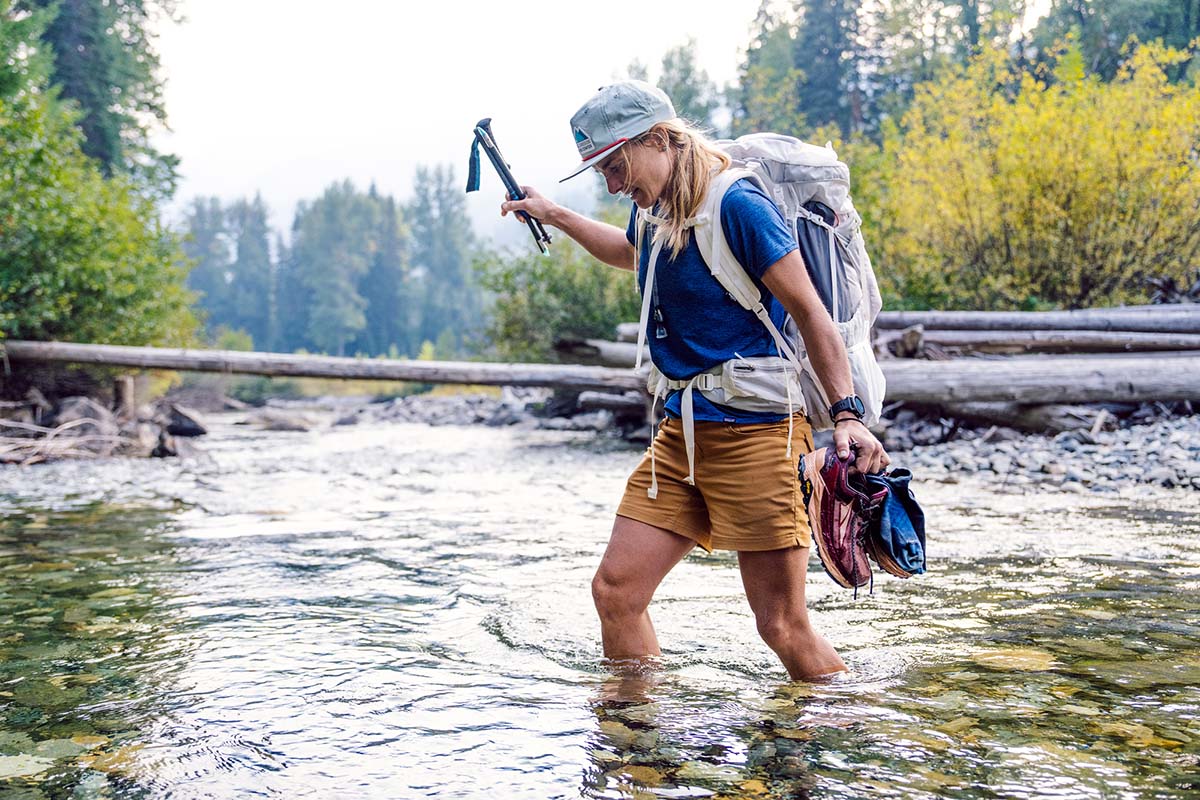
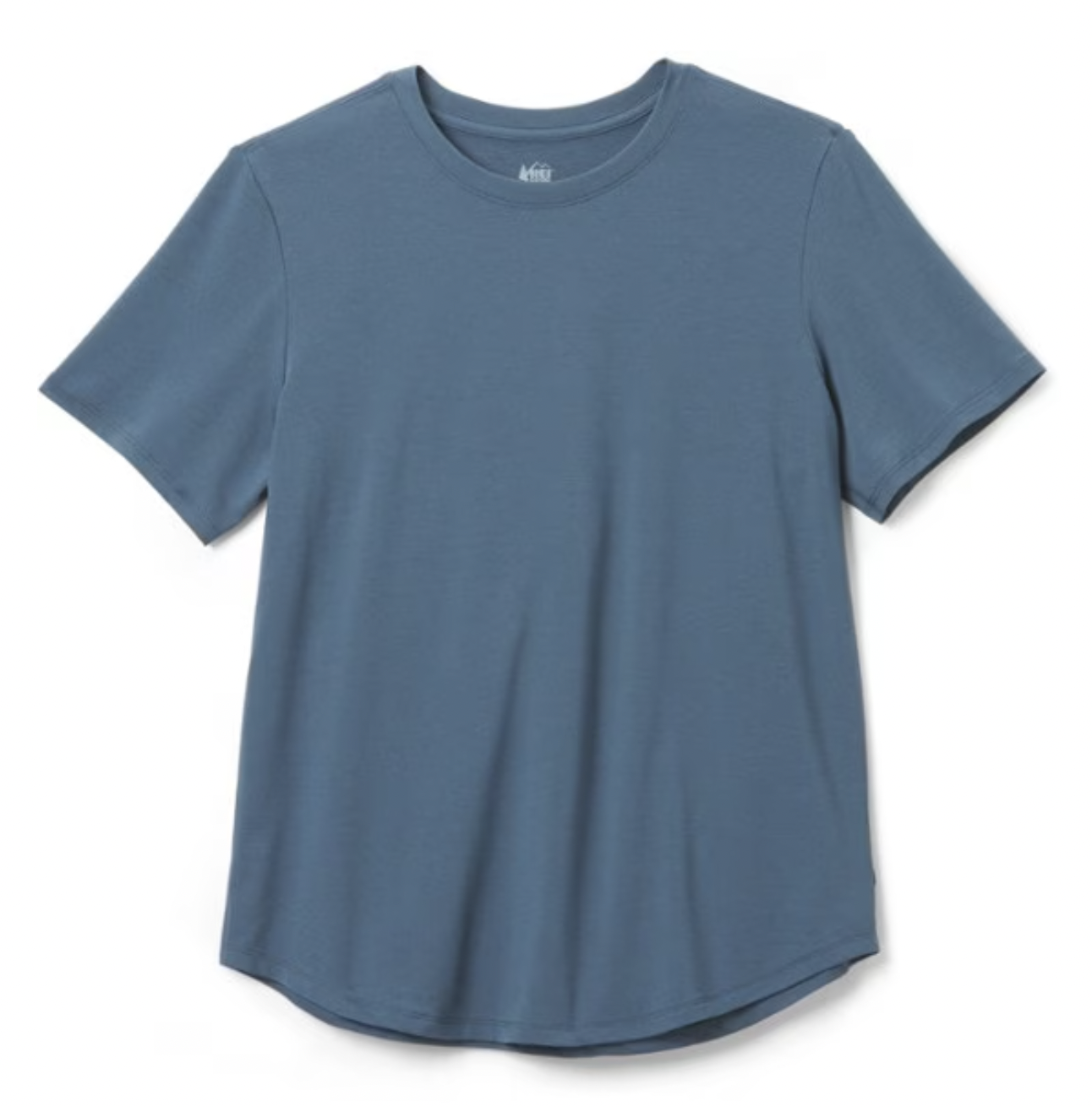 Materials: 92% polyester, 8% spandex
Materials: 92% polyester, 8% spandex
Weight: 3.8 oz. (small)
Styles: Tank, SS, LS, ¼-zip
What we like: Great performance and flattering fit for just $30.
What we don’t: Those with particular needs might need to spend up for other fabrics, fabric weights, or features.
Our top-ranked Capilene Cool Daily is pretty affordable at $45, but budget shoppers can do even better with the REI Active Pursuits here. For just $30, the Active Pursuits has a lot to offer: It’s quite soft and offers the performance characteristics we’ve come to expect from polyester (lightweight, breathable, moisture-wicking, and quick-drying). And unlike some other offerings from REI, the Active Pursuits actually has a really nice shape, which is relaxed without being too boxy (although some might want to size down), and features a curved hem for a nice combination of style and coverage.
What do you give up with such an affordable hiking shirt? Some women will want a trimmer fit or lighter fabric, like what you might find with the Patagonia Capilene Cool Lightweight. And don't expect merino wool levels of softness and odor resistance (compromises are expected at this price point). That said, you can buy two of the Active Pursuit T-shirts for less than most of the options here, which is appealing for a ton of obvious reasons. In the end, most casual hikers will love what the Active Pursuits has to offer, and like most REI-branded clothing, the shirt is available in many styles (long sleeve, tank, and a ¼ zip), as well as a large array of sizes, which is more than most shirts here can claim.
See the REI Co-op Active Pursuits T-Shirt
 Materials: 53% merino, 47% Tencel lyocell
Materials: 53% merino, 47% Tencel lyocell
Weight: 3.1 oz.
Styles: Tank, SS
What we like: All the benefits of merino in a lightweight, soft, and breathable design that feels athletic without being too body-hugging.
What we don’t: Absorbs moisture much more than polyester; slightly boxy fit; shows sweat more than other shirts.
Merino wool is far and away our favorite material for cold-weather baselayers and socks, thanks to its warm-yet-breathable, soft, and odor-resistant nature. But added insulation can be too much for warm-weather use, and thinner merino often results in a host of durability issues. Our favorite workaround for mild weather is a blended material, and the Smartwool Active Ultralite is our headliner for this category. This shirt features a mix of 53% merino and 47% lyocell, a fiber made partially from wood pulp. We tested the hybrid shirt side by side with Smartwool’s Merino SS (88% merino), and the differences were palpable: While the higher percentage of merino caused us to overheat on a number of occasions, the Active Ultralite felt light and smooth, kept air flowing, and was a great match for summer backpacking in the Cascades.
Pilling and other durability issues (such as little holes) can be one of the biggest downsides of lightweight merino shirts—we’ve experienced this with the Patagonia Capilene Cool Merino (65%) and Icebreaker Merino 150 Tech Lite below (100%)—but the Active Ultralite has yet to show signs of wear despite a lot of hard use. It’s not our first choice for particularly sweaty days or use around water, as lyocell and merino are both more absorbent than polyester, and we found this shirt to show more sweat than others. Plus, the fit of the Smartwool is slightly more boxy and relaxed than we prefer in a hiking shirt, although we’ll take it over the skintight look of other merino designs. All told, we love the feel and odor resistance of merino for everything from multi-day treks to casual day hikes, and the Active Ultralite pulls it off better than most.
See the Smartwool Active Ultralite Short Sleeve
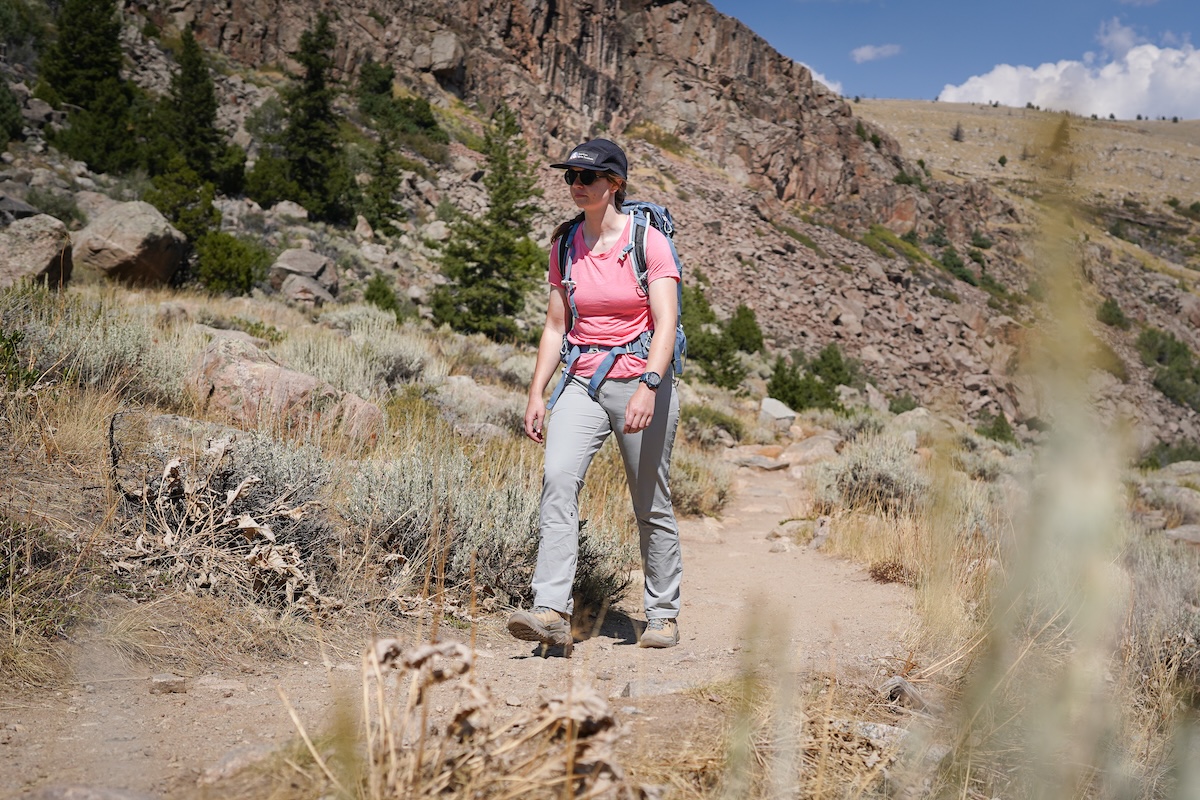
 Materials: 100% polyester
Materials: 100% polyester
Weight: 3.4 oz. (medium)
Styles: SS, LS
What we like: Nicely draped fit with UPF 40 sun protection; excellent wicking ability and lightweight feel.
What we don’t: Not as odor-resistant as shirts made with natural fibers.
While we love natural fibers for their high-performing odor resistance, they tend to soak up more sweat than synthetics, and sometimes we just want a classic lightweight polyester hiking shirt. We've worn this silky Columbia tee on fully exposed routes in the Tetons and peak-bagging in Oregon on 90-degree days, and its wicking fabric, moderate fit, and UPF 40 protection have proved a perfect in-between when we don't want a full sun shirt but need extra coverage and wicking ability. This shirt uses the brand's Omni-Freeze Zero tech woven into the fabric, which helps it pull sweat from the body instead of getting drenched as you might in a merino top. We've also put this shirt through some rugged trails and haven't noticed any pilling or abrasion in the tight weave, giving it another boost over some of our favorite merino options.
In our experience, the main downside to a fully synthetic shirt is poor odor resistance, and while the Cirque River Pro does a decent job keeping the stink at bay, it can't compare to natural fibers. A good alternative can be a fully synthetic button-down shirt like the Rabbit High Country or Outdoor Research Astroman Sun Shirt below, which have a less-clingy fit and the option to vent with the button-down style. But for a hot-weather shirt that wicks sweat and provides sun protection, the Cirque River Pro Short Sleeve (and the men's long-sleeve, if you want more coverage) has been a winner this season. For an even lighter shirt with more stretch, Rabbit's short-sleeve UPF tee is also fully synthetic, with 8% spandex for added stretch and perforations along the sides for airflow. This shirt has a less-dense weave than the Cirque River Pro, though, so the Columbia gets the edge for durability.
See the Columbia Cirque River Pro Short Sleeve

 Materials: 88% polyester, 12% spandex
Materials: 88% polyester, 12% spandex
Weight: 3.6 oz.
Styles: Tank, SS, LS, pullover
What we like: Classy style meets high-end comfort and performance.
What we don’t: Not great for layering or sleeping.
Button-up hiking shirts offer a boost in style compared to standard t-shirt designs and are just as at home on the trail as they are during après at the local brewery. They’re also more ventilated, which has its benefits in hot weather or if you’re building up heat while hiking fast. Among the options, the Rabbit High Country SS is our team’s runaway favorite. Don’t be fooled by the classy looks: the High Country is fully a performance piece. The stretchy polyester/spandex fabric feels noticeably premium and is highly mobile, lightweight, and a joy to wear, and Rabbit even included a subtly perforated back for increased venting.
Rabbit’s apparel is geared toward runners, but the High Country is durable enough to hold up to all manner of trail abuse. And while the ventilated backpanel was initially eyebrow-raising, it didn’t pose any issues under a full backpacking pack. What’s more, the metal snaps are well executed, hardwearing, and much quicker to operate than buttons. Plus, they’re spaced enough for air to flow through the gaps, which creates a really nice cooling effect. Do keep in mind that the button-up design isn't very versatile for activities like layering and sleeping, meaning it's not our first choice for extended backcountry trips. But if you like the style or are intrigued by the added ventilation, the High Country’s lightweight, stretchy, and airy personality makes it our favorite button-up hiking shirt of the year.
See the Rabbit High Country SS
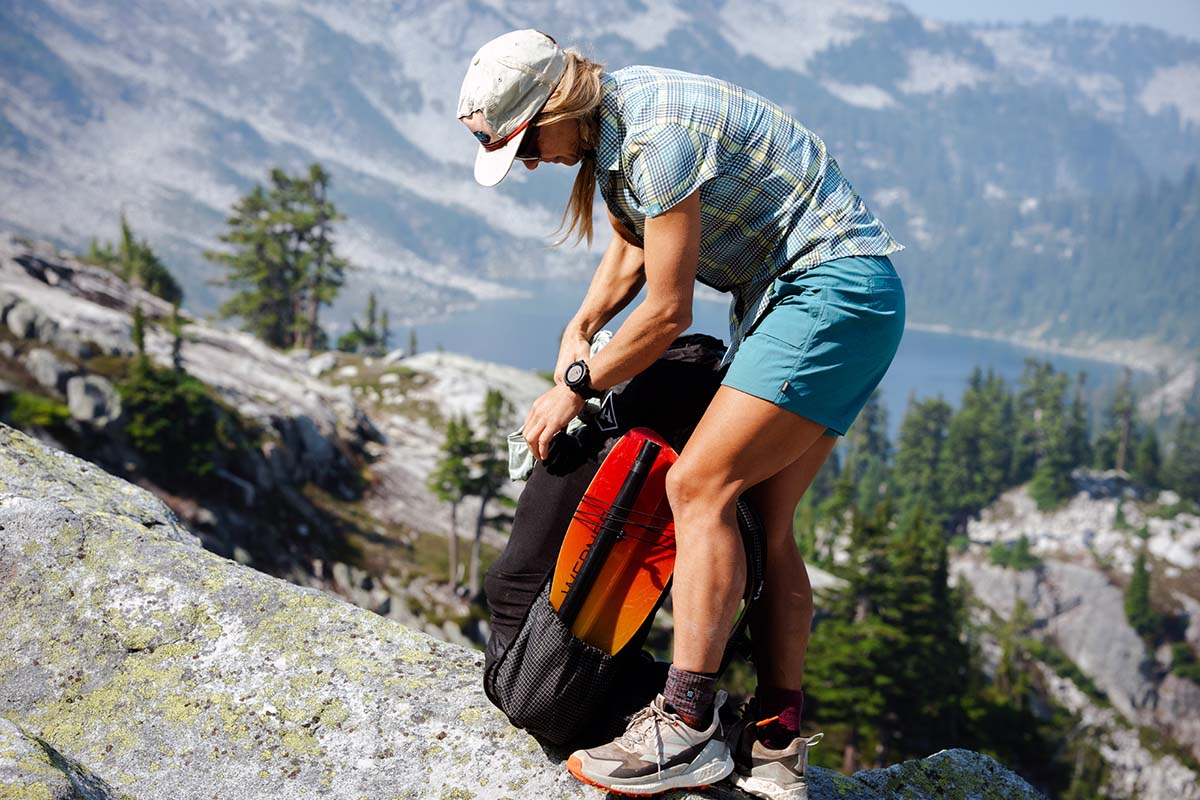
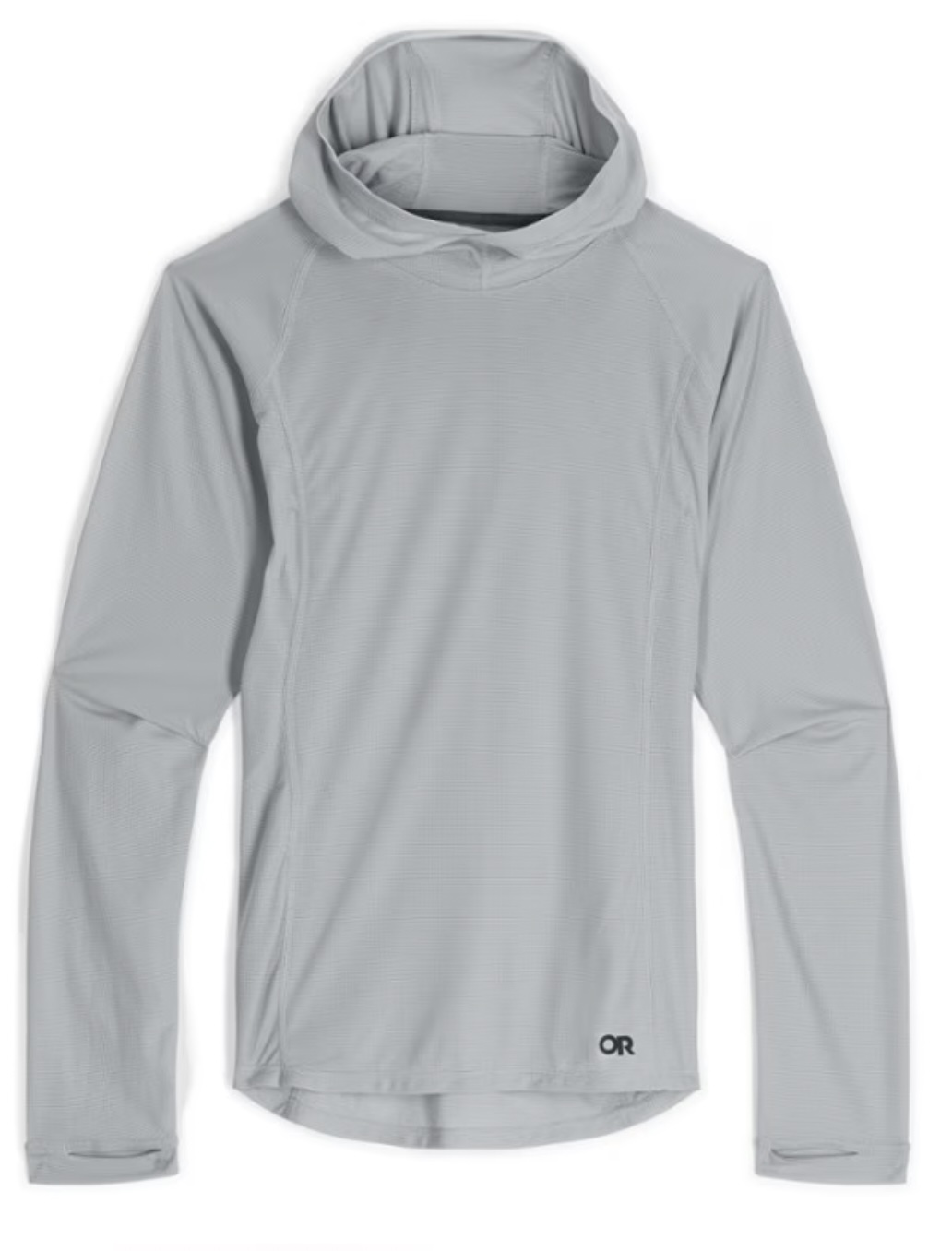 Material: 100% polyester
Material: 100% polyester
Weight: 3.9 oz.
Styles: Tank, SS, LS, hoody
What we like: Light, breathable, and quick to dry; lots of styles and sizing options; hood has a ponytail hole.
What we don’t: Fabric is prone to pilling and snagging; not the best UPF protection.
Ah, the sun hoody. We love this small but mighty piece of gear, which provides nearly complete protection from the sun without adding too much insulation. Among the options, we’re big fans of Outdoor Research’s Echo Hoodie for its low weight and airy feel. At just under 4 ounces and featuring a 100% polyester construction, the Echo breathes and wicks moisture better than most of the competition, making it a great pick for mid-summer hiking and other activities when you’re likely to work up a sweat. You also get surprisingly effective odor resistance thanks to OR’s ActiveFresh treatment. And with availability in 10 sizes for women (including plus sizes from 1X to 4X), plus several different styles to choose from, there’s likely an Echo for you.
While lightweight, however, the Echo's fabric has a tendency to pill and snag, and it’s noticeably less soft against the skin than alternatives like the Capilene Cool above and OR's own Essential Tank below. Compared to many other sun hoodies, including the REI Sahara Shade and Town Shirt Sun Hoodie below, the Echo also has a fairly low UPF rating of just 15. But some sun protection is better than 0%, which is what you’ll get when your thicker sun hoody heats up too much and you take it off, like our top-ranked Mountain Hardwear Crater Lake Hoody in our sun protection shirt guide. All told, for a breathable sun shirt ideal for hot hiking conditions, the OR is hard to beat.
See the Outdoor Research Echo Hoody

 Materials: 90% polyester, 10% spandex
Materials: 90% polyester, 10% spandex
Weight: 4.0 oz.
Styles: Tank, SS
What we like: Flattering shape and fit with enough coverage for wearing with a pack.
What we don’t: Not an ideal match for a weighted-down backpacking pack.
We don’t always recommend tank tops for hiking, especially when you’re schlepping a heavy backpack. Most don’t offer the coverage you need across the back and shoulders, which can lead to chafing, pressure points, fabric bunching, and more. But if you’re dead set on freeing your arms, the Outdoor Research Essential is a great option. Built with a buttery soft fabric, the Essential Tank offers generous shoulder, back, and hem coverage. And it looks good doing it—we’ve received a lot of compliments when wearing the OR, namely by women on a similar hunt for an under-the-backpack tank.
All that said, we still don’t recommend pairing the Essential Tank with too large of an overnight load. While decently wide, the fabric doesn’t extend all the way across the shoulders, which isn’t great for heavy backpacking packs with beefy shoulder straps (Smartwool's Active Ultralight High-Neck Tank has somewhat more coverage). A tank top can also be a risky choice for sunny days, as shoulders are a UV magnet, particularly at higher elevations. But if you’re not worried about sun exposure and are carrying a lighter and more minimalist daypack, the Essential Tank is a fun and flattering option, and we especially love the drop-tail hem for added coverage at the back. Within this category, it’s also worth checking out Oiselle’s Flyout Trail Tank, which was made specifically for pairing with a running hydration pack.
See the Outdoor Research Essential Tank
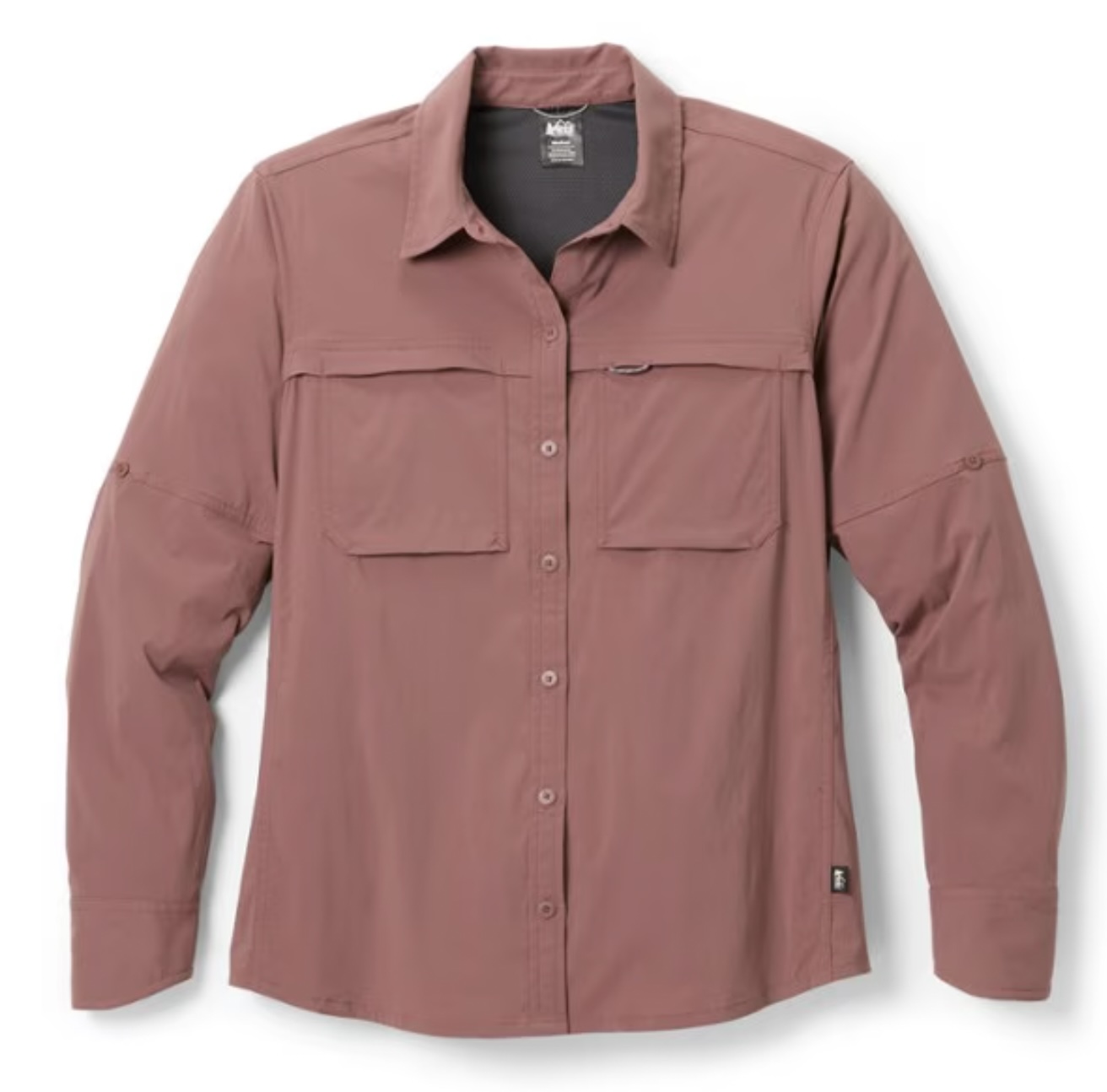 Materials: 94% nylon, 6% spandex
Materials: 94% nylon, 6% spandex
Weight: 6.7 oz.
Styles: LS
What we like: Great feature set and sun protection.
What we don’t: Nylon fabric is thicker and more rigid than most hiking shirts.
If you’re in the market for a traditional long-sleeved hiking shirt, the REI Co-op Sahara Solid is a classic go-to. With a design that’s equally at home for travel, going on safari, or hiking, the Sahara Solid features a full button-up closure at the front, collared neck, and a host of useful features. Storage is great for both on- and off-trail commutes, including two chest pockets with hook and loop closure, a secure zip pocket at the lower back, and a hang loop for sunglasses at the left chest. And when the mercury rises, a mesh-lined back vent keeps air flowing, and rolled-up sleeves secure with button tabs. Finally, the Sahara Solid touts a 50 UPF rating, which pairs well with its high-coverage design.
Unlike most of the synthetic shirts here, the Sahara Solid is built with nylon, which offers a boost in durability and water resistance compared to polyester. But while nylon is ideal for items like tents and hardshells, it’s a tougher sell in a shirt—the Sahara Solid has a sturdier feel than we’re used to and might cause overheating on particularly hot days. It also has a tendency to wrinkle, which we’d rather not deal with in a hiking shirt. Finally, we wish that REI had chosen a different placement for the zippered pocket—it lies right underneath a backpack’s hipbelt, and also makes the shirt difficult to tuck in (if that’s your style). But for day hikers and cool summer conditions, the Sahara Solid has a lot going for it, and availability in eight sizes and five colorways boosts its appeal.
See the REI Co-op Sahara LS Solid Shirt
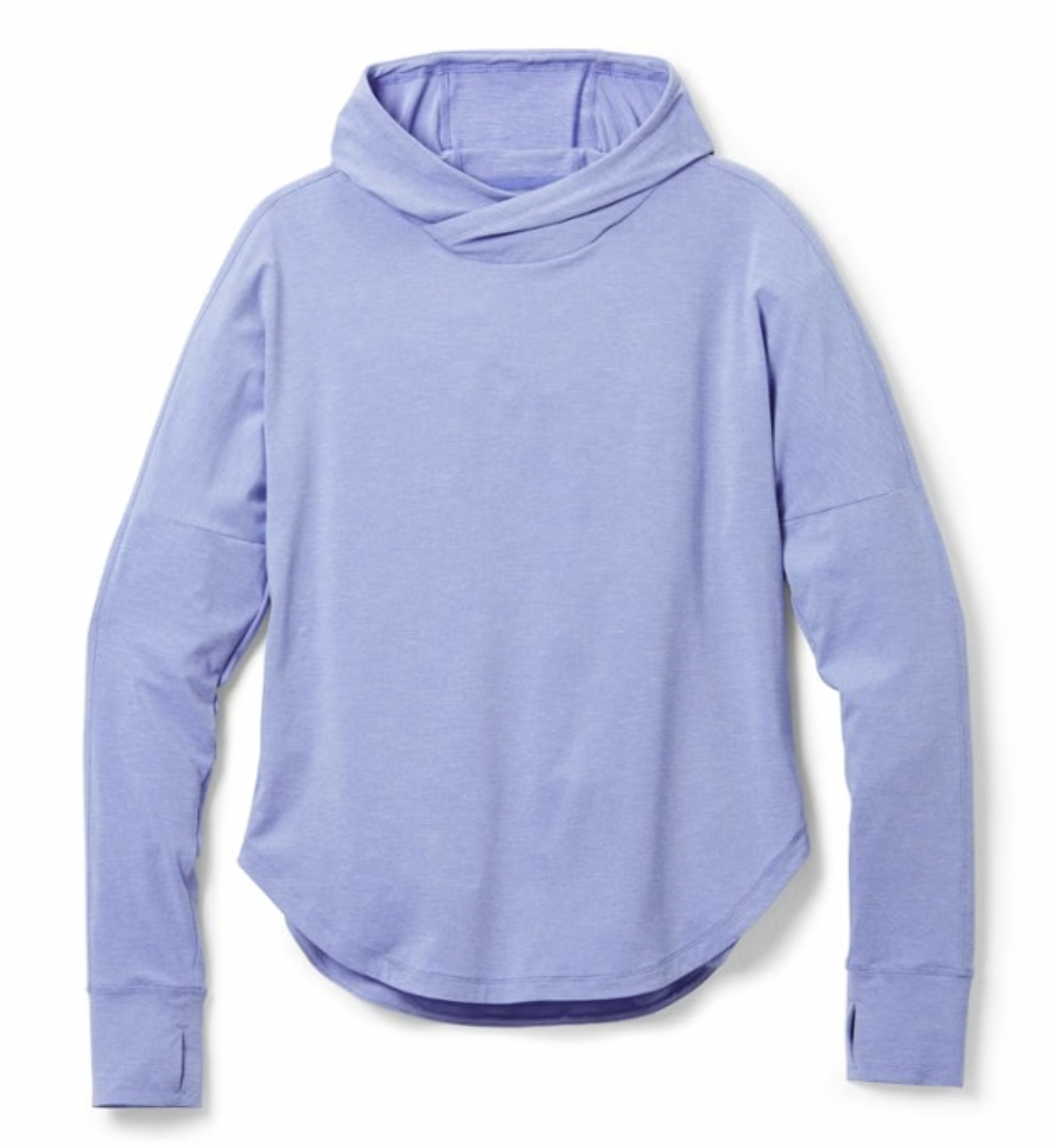 Materials: 92% polyester, 8% spandex
Materials: 92% polyester, 8% spandex
Weight: 6.4 oz.
Styles: SS, LS, hoody
What we like: Casual vibes with full-on sun protection.
What we don’t: Not everyone will love the roomy fit and shaped hem.
REI’s lighter Sahara collection goes in a different direction from the Sahara Solid above, with a buttery soft and stretchy polyester/spandex blend and simple design (available in short sleeve, long sleeve, and hoody styles). All three variations are worth trying, but the hoody has quickly become one of our favorite hiking tops. The bluesign-approved fabric feels high-quality, holds its shape between washings, and even offers a nice cooling effect in the hot sun. And unlike many performance-driven pieces, the Sahara Shade has a decently roomy fit, and the flowy drape is complemented by a scoop hem and subdued, pastel colorways. Some hikers might want a more technical vibe, but we think the Sahara Shade hits a nice balance for use both on and off the trail.
Compared to other sun hoodies, the Sahara Shade’s hood design is one of the best we’ve seen, with a hidden cinch that stays out of the way but still allows you to batten down the hatches in windy conditions. You also get well-designed low-profile thumbholes, along with an effective antimicrobial treatment and a UPF 50+ rating. Finally, reflecting REI’s push toward more inclusive sizing, the hoody is available in a great range of sizes, including women’s plus size options. All told, for a calm, cool, and relaxed sun hoody, the Sahara Shade is a very well-rounded and affordable pick.
See the REI Co-op Sahara Shade Hoodie
 Material: 100% merino
Material: 100% merino
Weight: 4.1 oz.
Styles: SS, LS
What we like: A cozy and odor-free shirt, great for multi-day trips and around-town use.
What we don’t: Absorbs moisture; will grow fuzzy over time.
Icebreaker's recently updated Merino 150 Tech Lite Short Sleeve (previously called the Tech Lite III) still features a 100%-merino construction and maintains the slightly relaxed fit of last year's model with a minor drop in weight. Despite the fully merino construction, this fabric is still delightfully stretchy with finer fibers, making an even airier shirt with less insulating properties for better performance in hot weather. This fully natural hiking shirt is highly odor-resistant, making it a great option for multi-day outings, and we tested a more fitted version on a summer backpacking trip in Washington’s Alpine Lakes Wilderness with no malodorous effects. Since then, we’ve kept reaching for this high-performing and never-stinky shirt for everything from daily runs, gym workouts, and even casual use. In essence, it offers most of the performance of polyester, but without the techy look and feel—a combination we love.
But a fully merino shirt does have its downsides, and despite the newly thinner build, the Merino 150 Tech Lite will still feel warmer and absorb more moisture than a fully synthetic or blended synthetic shirt. Our test model was perfectly serviceable up to the mid-70s Fahrenheit, but we wouldn't want to push it in warmer weather. And while the shirt will do a great job wicking sweat, this isn't the fastest-drying hiking shirt out there. Finally, 150-weight merino will always have durability issues, and our shirt has grown fairly fuzzy across the back and under where our backpack shoulder straps sit. But for the right applications in cooler weather, the Tech Lite is a great-looking and great-feeling merino shirt. Icebreaker also offers the Merino Blend 125 Cool-Lite Sphere, which features a more lightweight build with 60% lyocell and 40% merino.
See the Icebreaker Merino 150 Tech Lite Short Sleeve
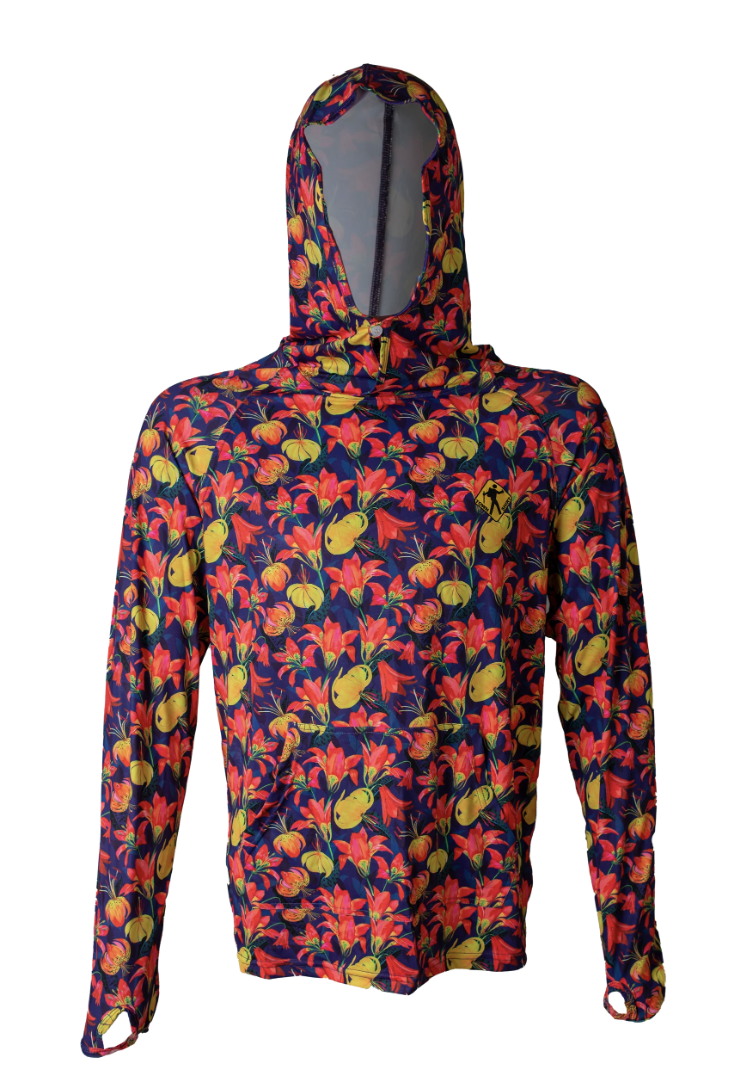 Materials: 88% polyester, 12% spandex
Materials: 88% polyester, 12% spandex
Weight: 7.5 oz. (XS)
Styles: Hoody
What we like: Loose, free-flowing cut and highly odor-resistant—a great combination for long-distance hikers.
What we don’t: Relatively floppy hood, thicker than the OR Echo, and stock can be hit or miss.
Town Shirt is a niche hiking apparel brand inspired by the founder's own thru-hikes, which involve spending weeks (or months) on the trail with a very limited wardrobe. To that end, Town Shirt’s Sun Hoodie is one of our favorite tools for the job. With a silky-smooth fabric and looser cut than hoodies like the OR Echo above, the Town Shirt allows for excellent airflow on hot days, and we’ve found odor resistance to be on par with treatments like OR’s ActiveFresh in the Echo. Last but certainly not least, we’re big fans of the unique patterns and colorways, which are all based on plants and animals commonly found along popular long-distance trails in the U.S.
Compared to the OR Echo Hoodie above, we found the looser-fitting Town Shirt to be more comfortable for wearing multiple days in a row, as it’s less prone to clinging as you work up a sweat. You also get better sun protection (UPF 50 vs. 15 for the Echo), along with less susceptibility to snags and pilling, although the Echo is notably thinner and lighter. The Town Shirt’s hood is also relatively floppy, which is nice for coverage but can impede peripheral vision compared to the Echo’s more fitted hood. Apart from these complaints, our only knock against Town Shirt is that availability can be hit or miss—this is a small cottage brand, and your favorite pattern or preferred size may not be in stock, especially during peak season. But if you can track one down, the Sun Hoodie certainly pumps some fun into the hiking shirt market. Town Shirt also offers technical short-sleeve button-downs in a similarly exciting mix of patterns and colorways.
See the Town Shirt Sun Hoodie
 Material: 100% polyester
Material: 100% polyester
Weight: 3.0 oz.
Styles: Tank, SS, LS, hoody
What we like: A premium hiking shirt for hot-weather adventures.
What we don’t: Expensive for a polyester design.
Based in the lush Coast Range of British Columbia, Arc’teryx knows a thing or two about proper layering for changing mountain weather. The Taema is a 100%-polyester shirt that features the brand’s Phasic LT fabric, a relatively thin material with a good bit of mechanical stretch. In many ways it feels like a softer and better-made Echo (above)... with the corresponding price bump. If you're willing to pay, the Taema is a great match for high-output use and true summertime temperatures, and is one of the most premium hiking shirts on this list.
Arc’teryx revised the fit of the Taema last year, and reviews have been mixed. We love the long cut (nothing’s worse than a too-short hiking shirt poking out over your backpack hipbelt) and roominess of the regular fit, but some women will want a trimmer, more shapely design. If that’s you, the Outdoor Research Echo T-Shirt or Patagonia Capilene Cool Lightweight above might be better hot-weather options. But as with everything Arc’teryx, the Taema is extremely well executed. We’ve used various blends of their Phasic fabric over the years and have always been impressed with how it holds up over time. If the $70 price tag doesn’t put you off, the Taema is a solid choice for everything from hiking to running, climbing, biking, and more.
See the Arc’teryx Taema Crew Neck
 Material: 100% polyester
Material: 100% polyester
Styles: SS, LS
What we like: A lightweight button-up with subdued vibes and great ventilation.
What we don’t: A bit short and boxy; we prefer snaps over buttons.
After trying the Rabbit High Country above, we have little need for any other button-up hiking shirt—it’s just that good. That said, we respect that the techy, perforated backpanel and $75 price tag aren’t for everyone. If you’re looking for a more subdued button-up, check out the Columbia Silver Ridge Utility, which starts with a similar foundation of a stretchy polyester fabric. Columbia thought through the details of this one, placing two easy-to-operate snaps near the neck (the rest of the front panel uses buttons) and employing large shoulder vents to keep air flowing. The venting doesn’t work perfectly while wearing a backpacking pack, but the Silver Ridge is nevertheless a very breezy shirt and good for hot-weather hiking.
The Silver Ridge Utility also comes in a long-sleeve version, which offers a great alternative to the Sahara Solid above. The Columbia’s polyester fabric is noticeably thinner and more pliable than the REI’s nylon, but you still get UPF 50 sun protection. Overall, we think it’s a better match for warm temperatures, while the Sahara Solid gets the edge for cooler and wetter weather. It’s worth noting that both versions of the Silver Ridge Utility are short and boxy and run a bit large, which won’t work for everyone.
See the Columbia Silver Ridge Utility Short Sleeve
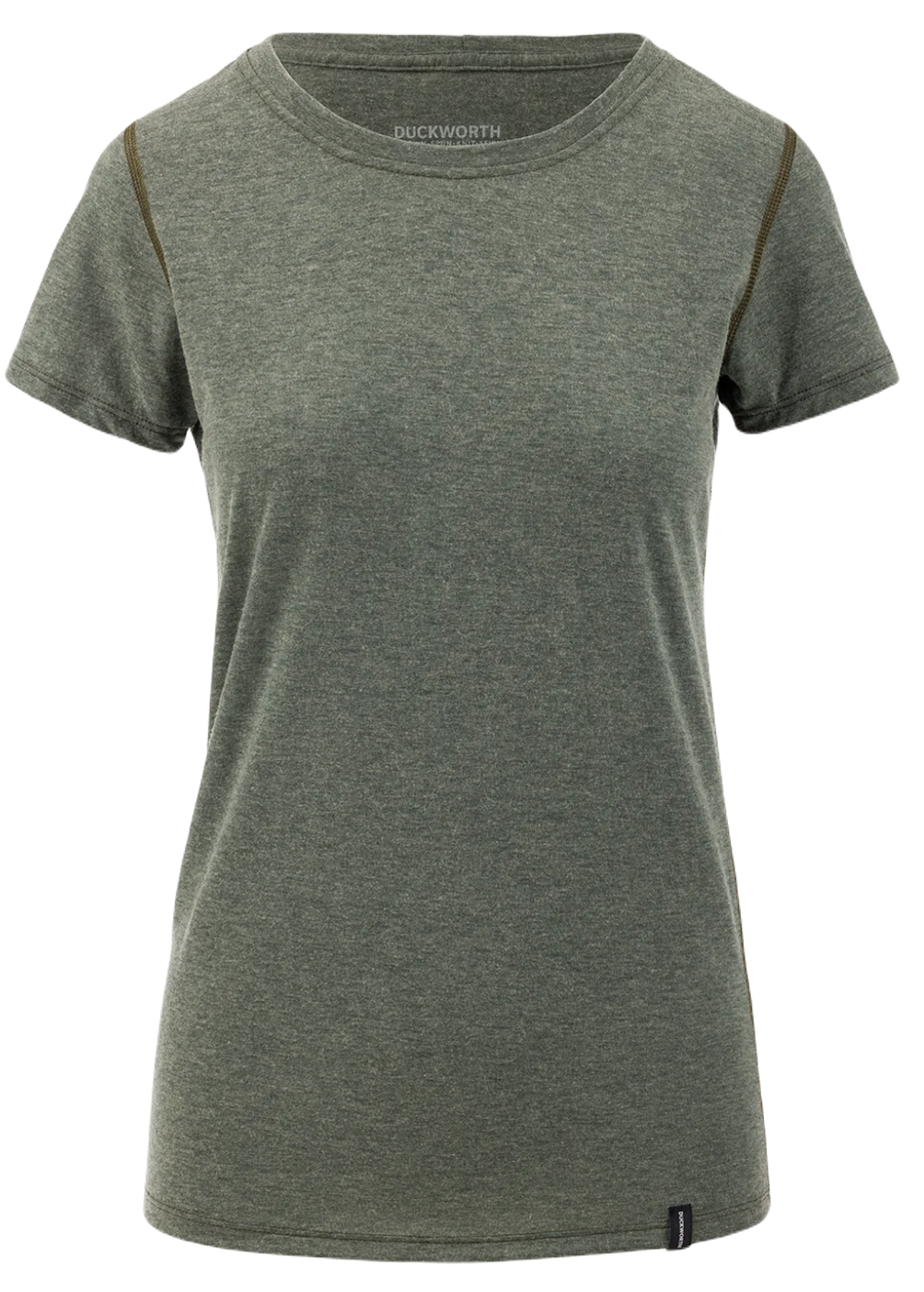 Materials: 38% merino, 50% polyester, 12% modal
Materials: 38% merino, 50% polyester, 12% modal
Styles: SS, LS, tank, hoody
What we like: A soft, durable shirt with incredible odor-resisting properties.
What we don’t: Absorbs water and isn’t super quick to dry.
This soft, stylish tee looks perfectly acceptable when worn with jeans in town, but is deceptively high-performing on the trail. Built with a blend of lightweight (150 gsm) merino wool, the Duckworth Vapor Tee is airy, silky smooth, and incredibly durable. The softness and durability come from the addition of polyester combined with modal, a pulp made from beechwood (similar in feel to Tencel), a unique material combination not found anywhere else on this list. We also love that this Montana-based brand's clothes are made in the U.S., with Montana-sourced merino and tested in the mountains around their headquarters in Bozeman.
We wore the Vapor Tee for nine weeks during an extended backcountry trip, and the shirt carried almost no odor and showed hardly any dirt. It was easy to clean, and we're also fans of the Vapor line's other options, including hoodies and tanks. So why does it rank lower? With so many merino tees on this list, the Vapor Tee is in tough competition. In this case, it comes down to style. This tee is more fitted than the Ridge Merino Wander Crew Neck below, and some hikers might prefer a slightly roomier fit like the Smartwool Active Ultralight Tee above, which also uses a wood-pulp merino blend, albeit without the added durability of polyester.
See the Duckworth Vapor Tee
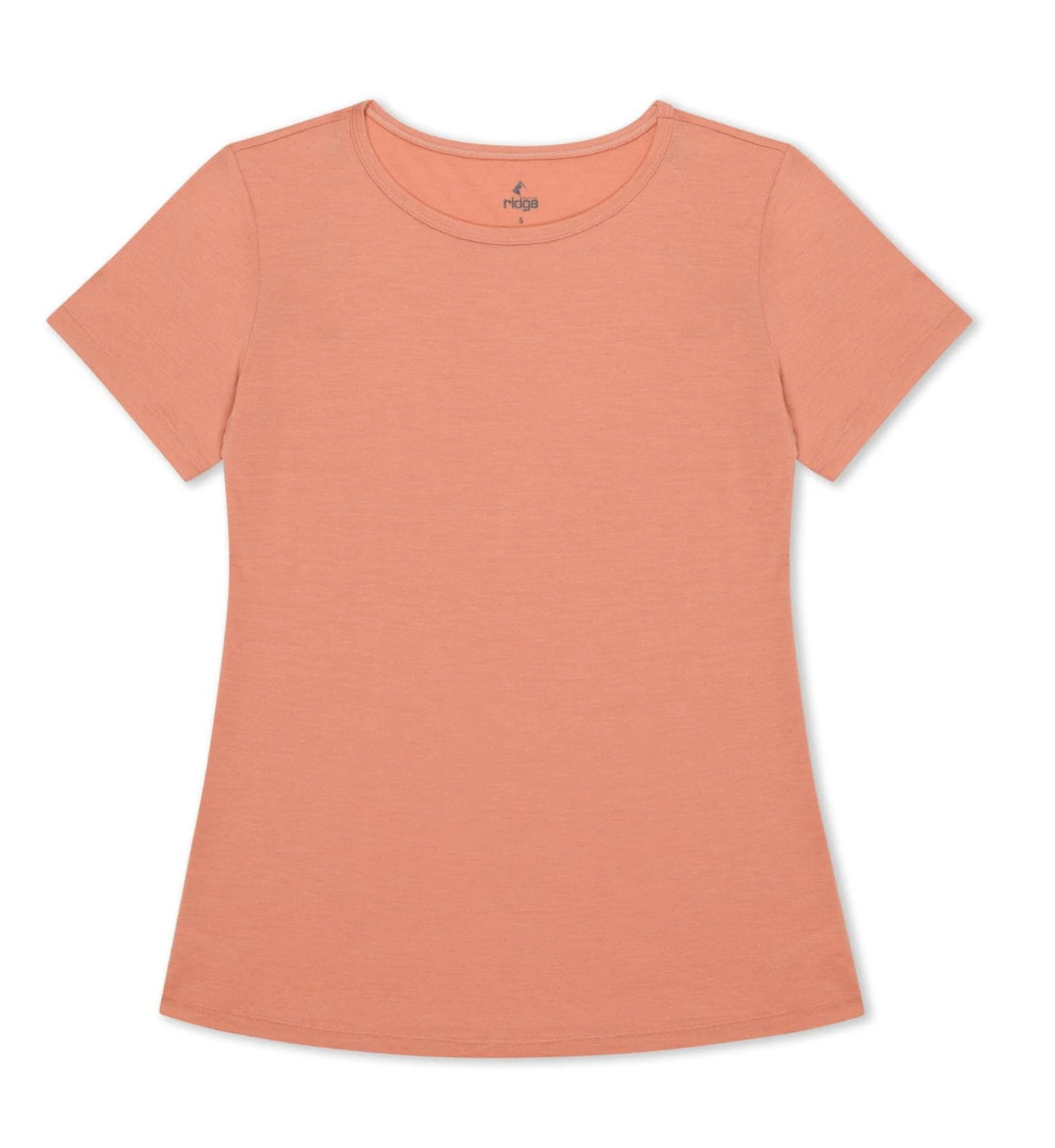 Materials: 87% merino, 13% nylon
Materials: 87% merino, 13% nylon
Styles: SS (crew and V-neck)
What we like: A thin yet durable merino shirt.
What we don’t: Only available in crew- and V-neck short-sleeve styles; best for low-output and casual use.
At this point, you know our gripes about merino hiking shirts: They can run warm, aren’t as durable as synthetics, and hold onto moisture, which isn’t great news for hot temps and sweaty hikers. But despite the downsides, we still love this miracle fabric for its soft and natural feel and odor-wicking properties, and we reach for it often for low-output activities and around-town use. Fans of merino should check out Ridge Merino, a California-based company with a small lineup of offerings that are priced very competitively.
The Ridge Merino Wander is available in both crew- and V-neck versions, both with a relaxed fit with a bit of shape through the waist. The Wander splits the material difference nicely between the Smartwool Active Ultralite and Icebreaker Tech Lite: 13% nylon adds some durability without detracting from the merino look and feel, and the price is right at $60 ($5 cheaper than the Smartwool and $20 cheaper than the Icebreaker). We’ve also found it to be a touch thinner than the Tech Lite III, which is great news for warm conditions. For an even higher nylon content, we love the Patagonia Capilene Cool Merino, but expect thinner fabric and some pilling issues. Finally, we have also been loving Ridge's Pursuit Ultralight Merino Tee, a lighter option (135 gsm vs. 145 gsm) with more stretch.
See the Ridge Merino Wander Crew Neck
 Materials: 85% nylon, 15% spandex
Materials: 85% nylon, 15% spandex
Weight: 4.9 oz.
Styles: SS, LS
What we like: A fun and flowy button-up with a lightweight yet technical fabric.
What we don’t: Fit won’t be ideal for everyone.
If you’re searching for that easy, breezy button-up that will keep air flowing and the sun off your shoulders, the OR Astroman Sun Shirt is a solid option. With cuffed sleeves, pleating at the front shoulders and center back, and a drop-tail hem, the Astroman has a light and playful look that belies its technical prowess. Under the hood, it’s ready for action, with OR's lightweight, stretchy, durable Astroman fabric that feels similar to an ultralight softshell. It offers UPF 30-50 sun protection and has a hidden zippered pocket at the right hip, which is a fun feature that we've found handy.
Many women will like the Astroman’s roomy and free-flowing style, but it’s not particularly ideal for use underneath a backpack. OR claims that the shirt was built to pair well with a hipbelt or climbing harness, but we’d love a little more length for some extra assurance. And finally, after experiencing the user-friendliness of a snap closure on the Rabbit High Country above, we wish every button-up used metal snaps rather than traditional buttons. Gripes aside, the Astroman Sun Shirt is a great mix of form and function and a particularly fun option for adventures that don’t involve a ton of time wearing a backpack, including paddling, biking, and climbing.
See the Outdoor Research Astroman Sun Shirt
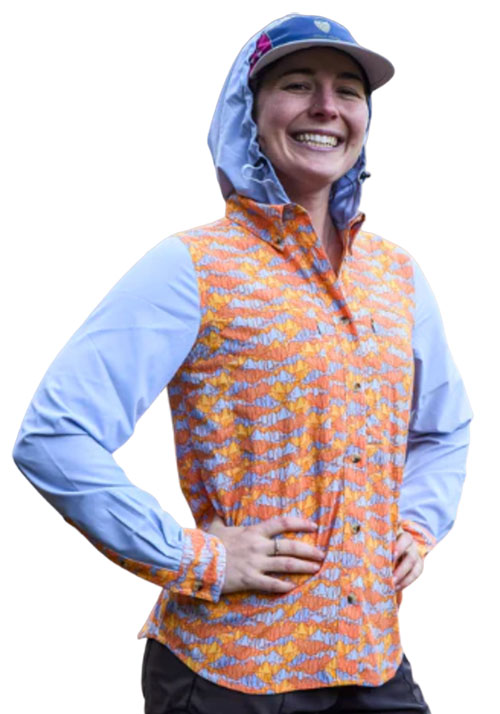 Materials: 86% polyester, 14% spandex
Materials: 86% polyester, 14% spandex
Weight: 8.5 oz.
Styles: SS, LS
What we like: Best of both worlds combo of sun protection and ventilation.
What we don’t: Not everyone will love the thru-hiking personality.
If you’ve spent any time on long-distance trails like the PCT, CDT, or AT, chances are high you’ve seen the Jolly Gear Triple Crown Button Down. Designed and built by a thru-hiker named Jolly who knows firsthand the need for breathable sun protection, the Triple Crown Button Down combines the hood of a standard sun hoody with the button-up ventilation of a hiking shirt. Aside from the brilliant Frankensteined design, our favorite thing about the Triple Crown is the variety of fun patterns, all of which are built with stretchy, antimicrobial (read: odor-resistant) polyester. The shirt is made in both long- and short-sleeved versions, and Jolly Gear also offers sun sleeves (a $35 add-on) for those who choose the latter.
Standard sun shirts can offer some amount of cooling, but the effect is limited on truly hot days—with no way to ventilate, the long-sleeve design can grow too warm (especially if you’re also generating your own heat). And while button-up hiking shirts are a dime a dozen, they don’t offer the complete protection of a hooded design. For this reason, the Triple Crown Button Down is an outstanding hybrid and truly the best of both worlds for serious hikers who care about sun protection—if you can handle its distinct thru-hiker personality and decidedly flashy looks.
See the Jolly Gear Triple Crown Button Down
| Hiking Shirt | Price | Materials | Weight | Styles |
|---|---|---|---|---|
| Patagonia Capilene Cool Daily | $45 | 100% polyester | 3.7 oz. | Tank, SS, LS, hoody |
| REI Co-op Active Pursuits | $30 | 92% polyester, 8% spandex | 3.8 oz. | Tank, SS, LS, ¼-zip |
| Smartwool Active Ultralite SS | $65 | 53% merino, 47% lyocell | 3.1 oz. | Tank, SS |
| Columbia Cirque River Pro SS | $55 | 100% polyester | 3.4 oz. | SS LS |
| Rabbit High Country SS | $75 | 88% polyester, 12% spandex | 3.6 oz. | Tank, SS, LS, pullover |
| OR Echo Hoodie | $75 | 100% polyester | 3.9 oz. | Tank, SS, LS, hoody |
| OR Essential Tank | $44 | 90% polyester, 10% spandex | 4.0 oz. | Tank, SS |
| REI Co-op Sahara Solid LS | $70 | 94% nylon, 6% spandex | 6.7 oz. | LS |
| REI Co-op Sahara Shade Hoodie | $50 | 92% polyester, 8% spandex | 6.4 oz. | SS, LS, hoody |
| Icebreaker Merino 150 Tech Lite | $80 | 100% merino | 4.1 oz. | SS, LS |
| Town Shirt Sun Hoodie | $85 | 88% polyester, 12% spandex | 7.5 oz. | Hoody |
| Arc’teryx Taema Crew Neck | $70 | 100% polyester | 3.0 oz. | Tank, SS, LS, hoody |
| Columbia Silver Ridge Utility SS | $55 | 100% polyester | Unavail. | SS, LS |
| Duckworth Vapor Tee | $69 | 38% merino, 50% polyester, 12% modal | Unavail. | SS, LS, tank, hoody |
| Ridge Merino Wander Crew | $60 | 87% merino, 13% nylon | Unavail. | SS (crew, V-neck) |
| OR Astroman Sun Shirt | $99 | 85% nylon, 15% spandex | 4.9 oz. | SS, LS |
| Jolly Gear Triple Crown | $95 | 86% polyester, 14% spandex | 8.5 oz. | SS, LS |
Hiking shirts come in all shapes and sizes, from tank tops for staying cool on hot-weather hikes to sun hoodies for maximizing coverage against harmful UV rays. The female editors at Switchback Travel vary in terms of their preferred style—former senior editor Jenny Abegg, who put together this guide in late 2023, typically wears short-sleeve tops for hiking and backpacking, while contributing editor Maggie Slepian (who currently manages the guide) is a sucker for sun hoodies. We made sure to prioritize designs offered in multiple styles to fit the varied needs of female hikers and backpackers. Depending on your preferences and intended use(s), we’ve also put together detailed guides on the best sun protection shirts and best women’s baselayers, the latter of which covers long-sleeve designs.
In addition to available styles, we looked at several other factors in deciding which hiking shirts to feature. Our favorite designs wick moisture effectively, keep air flowing, and move with us. They also fend off odor between washings, offer sun protection in the form of UV resistance, and are resistant to durability issues like snags and pilling. Finally, while fit is entirely subjective, we look for shirts that are flattering but not restrictive, with a long-enough hem to clear a backpack hipbelt or climbing harness. As the hiking shirt market evolves, we’ll continue putting new and noteworthy designs to the test, amending our list above to reflect our current favorites.

Synthetics (Polyester and Nylon)
The majority of hiking shirts are made with at least some polyester, which is soft and comfortable, lightweight and breathable, moisture-wicking and fast-drying, and impressively abrasion-resistant for the thickness. Polyester is also robust enough to keep most UV radiation at bay. Some shirts, like the traditional button-up REI Sahara Solid or climbing-ready Outdoor Research Astroman Sun Shirt, use nylon, which is another synthetic that’s generally a bit stiffer and more durable but not as comfortable or moisture-wicking as polyester. The primary downfall of both polyester and nylon is that these materials can really hold a stink, although most shirts now include fairly effective odor-resistant treatments. All told, for the vast majority of use cases—particularly for warm weather and activities around water—synthetic hiking shirts are our top choice.
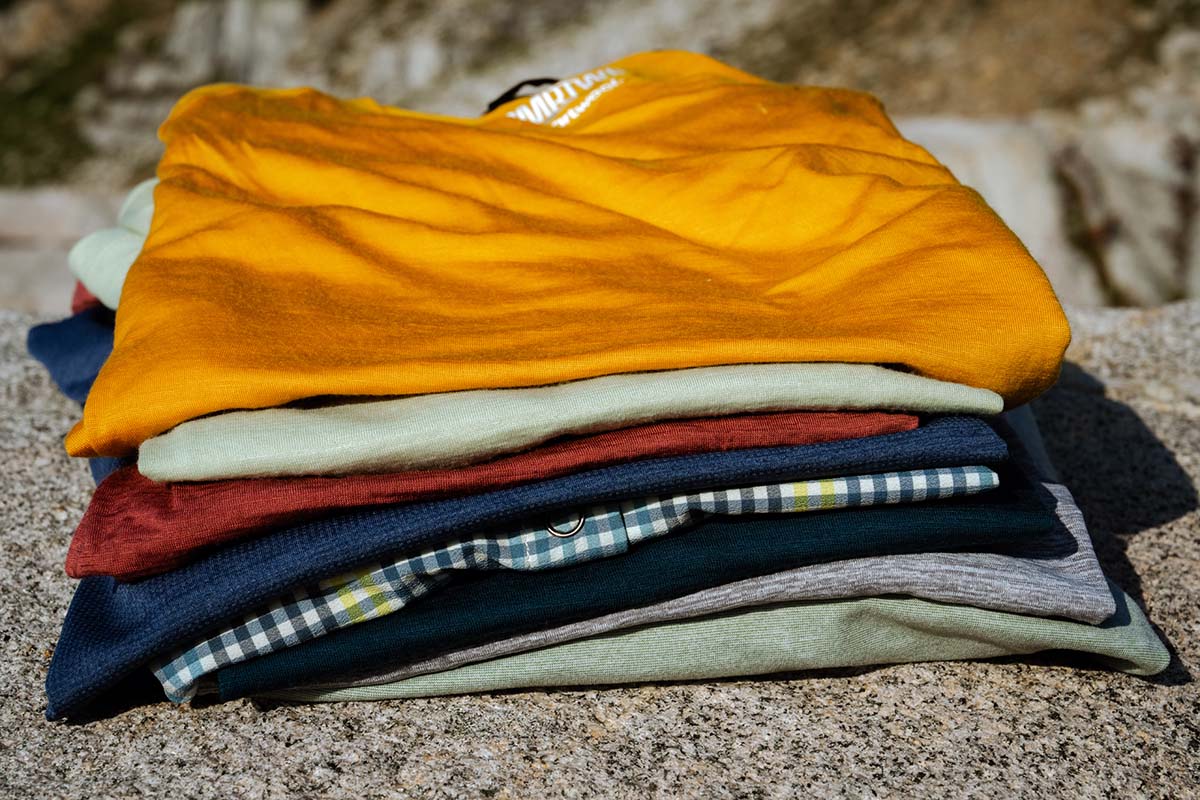
Merino Wool
Merino is our favorite material for cold-weather baselayers and socks, thanks to its warm, breathable, soft, and antimicrobial nature. We also love it as the key material in our hiking shirts, with a few caveats.
Merino's insulating properties can be a bit too much for warm temperatures, and you'll want to take care in selecting a light enough material. This can be difficult to discern online, but in general, lower fabric weights (often measured in grams per square meter, or gsm) will be lighter, and blended tops with polyester, nylon, or lyocell can also feel lighter. Another caveat is that merino absorbs more moisture than synthetics like polyester, which means it can become heavy and slow to dry—not great for drenching or sweaty conditions, though merino does still insulate when wet. And finally, it's not particularly durable, and we recommend looking for blended fabrics over pure merino if you predict you'll be hiking in high-abrasion situations. Caveats aside, we find ourselves reaching for our merino hiking shirts at least half the time, especially for multi-day trips or crossover use. They have a nice casual vibe compared to techy synthetics, are delightfully soft, and their odor resistance is unmatched.

Cotton
We don't often see cotton used in outdoor clothing, and hiking shirts are no exception. In fact, there's even an old adage that says "cotton kills." The reason is this: Cotton absorbs moisture and doesn't dry quickly. Unlike merino, it does not continue to insulate when wet. This can be a dangerous combination for backpacking, especially in alpine zones or during shoulder seasons when things can cool down quickly. However, you can get away with cotton for day trips in dry and sunny areas like the Utah desert—in fact, some actually prefer it for its cooling abilities (just get it wet and you'll have natural AC all day). And as we all know, cotton is soft and comfortable, and is decently breathable too (especially thinner varieties). We don't have any dedicated cotton shirts on our list, but they're a dime a dozen, even from brands like Patagonia and REI Co-op.
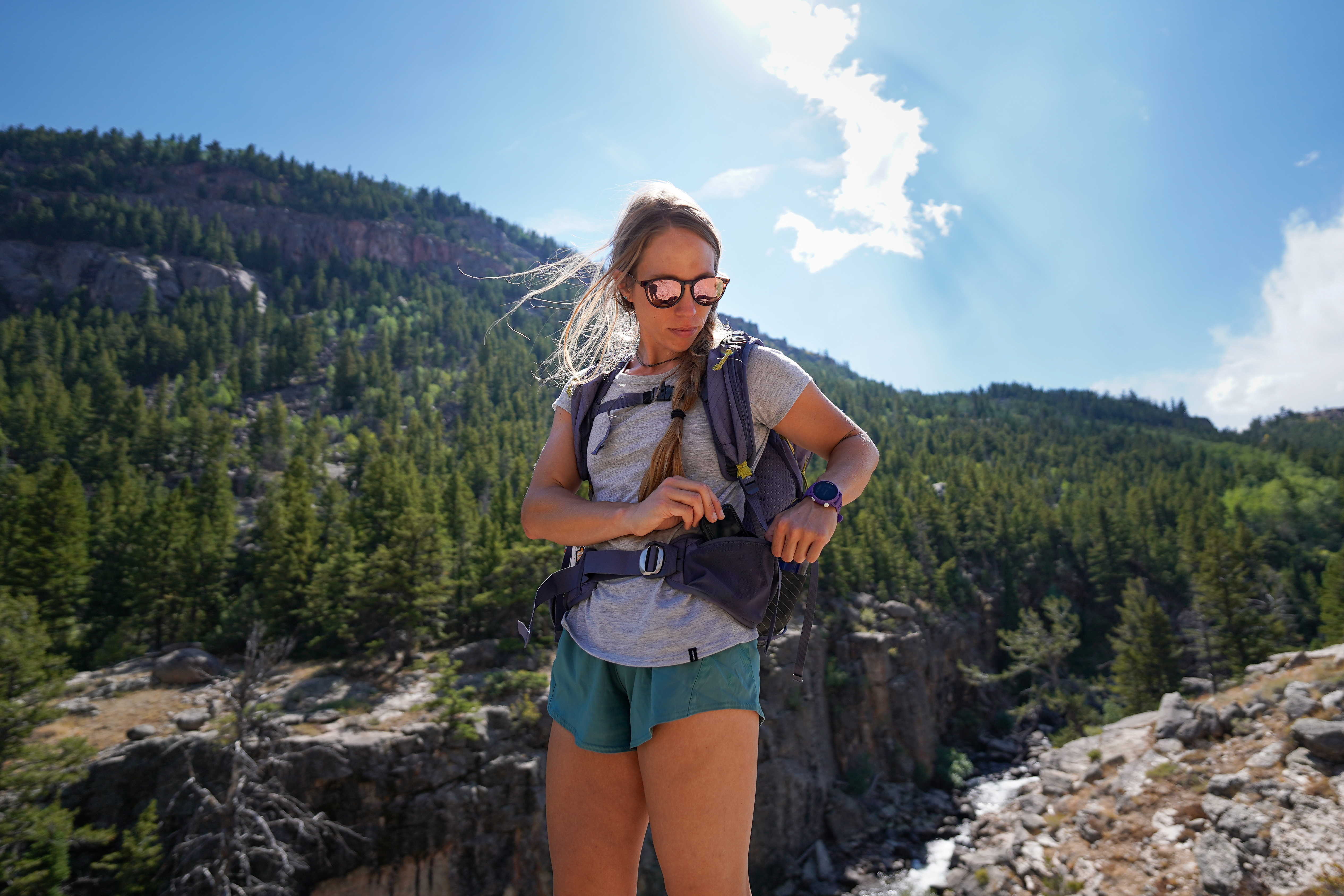
Other Natural Fibers
A few hiking shirts above use modal and lyocell, which are two similar fibers derived from wood pulp. Both materials are incredibly soft, offer a cooling effect, and are highly breathable. They're also very water absorbent—lyocell is said to be 50% more absorbent than cotton—which means they're great for wicking moisture away from the skin. But like merino, they can grow heavy with water and don't dry out particularly quickly. These fibers are often blended with merino (as seen in the Smartwool Active Ultralite and Duckworth Vapor Tee) to add durability and softness. It's worth noting that lyocell, modal, and merino require extra care when it comes to laundering, and won’t hold up to heavy use as well as comparable synthetics (those blended with polyester generally fare best). Regardless of their downsides, fibers like lyocell and viscose are well worth checking out, particularly for the comfort they offer.
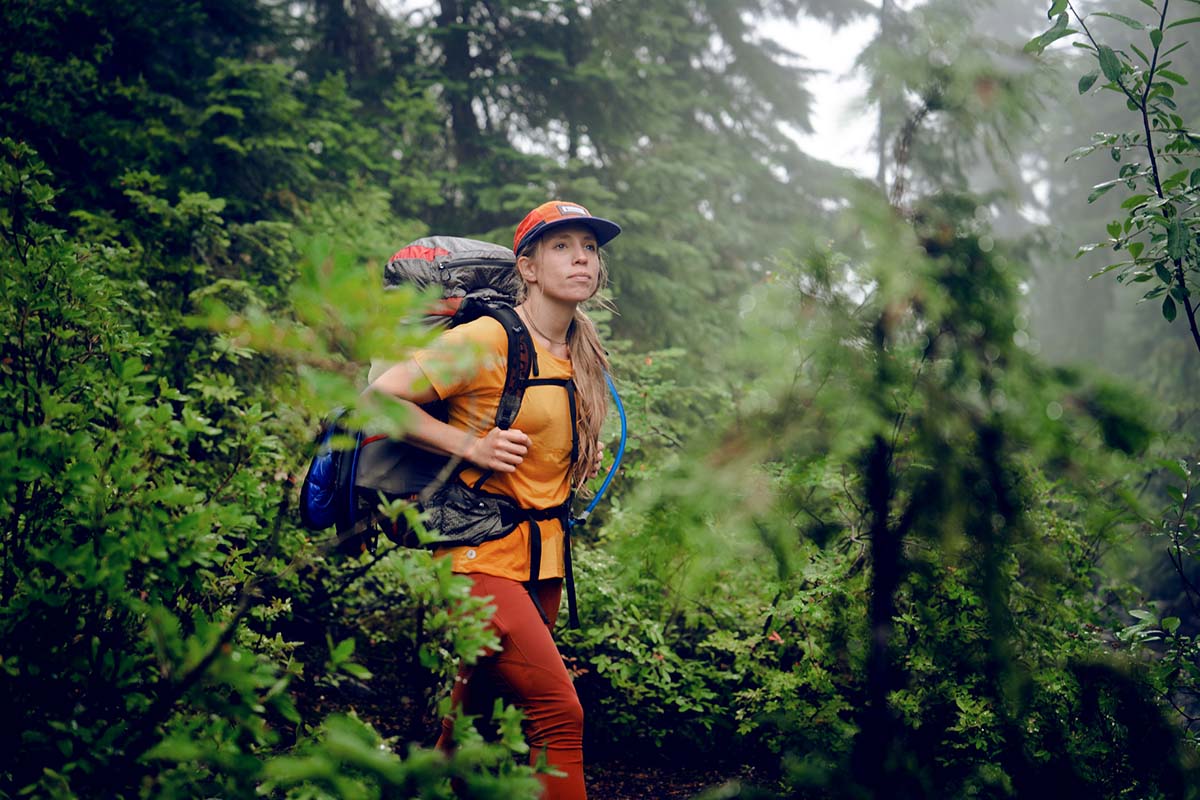
Many of the hiking shirts above come in multiple styles, including tank top, short-sleeve (SS), long-sleeve (LS), and hoody variations. In most cases, a short-sleeve t-shirt is the most versatile style—it’s airy enough to keep you cool on warm days, yet covers enough to avoid sunburned shoulders or chafing from pack straps contact. However, there are some merits to the other varieties. Tank tops can be a great choice for those who need a lot of ventilation (and don’t mind the sun exposure), and many varieties, like the Outdoor Research Essential Tank, are designed to offer coverage underneath a backpack. On the other hand, long sleeves and hoodies boost sun protection with coverage and UPF ratings, and many feature roomy designs that keep air flowing.
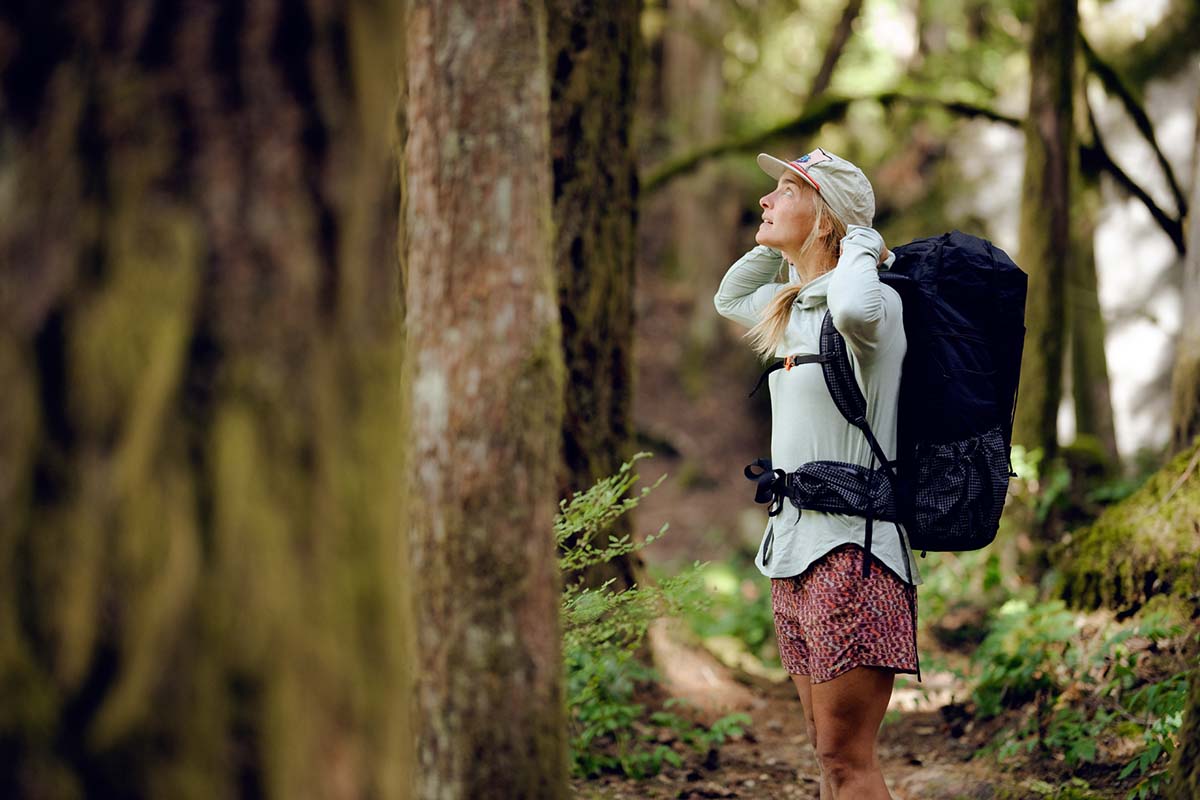
Some hikers will opt for a button-up shirt, which come in both short- and long-sleeve varieties. Aside from style, one of the benefits of a button-up is its built-in ventilation. Along with the front venting (the gaps between the buttons/snaps), many shirts incorporate venting at the rear: The Rabbit High Country has a perforated back, while the Sahara Solid has a horizontal vent across the back with mesh underlay. Button-ups aren’t our top choice for layering (the front panel of snaps is bulky under a snug baselayer), and they’re not super comfortable to sleep in, so they do have their limitations compared to standard t-shirt designs. But for great sun protection (especially in the long-sleeved varieties) alongside natural cooling, they’re a really nice option.
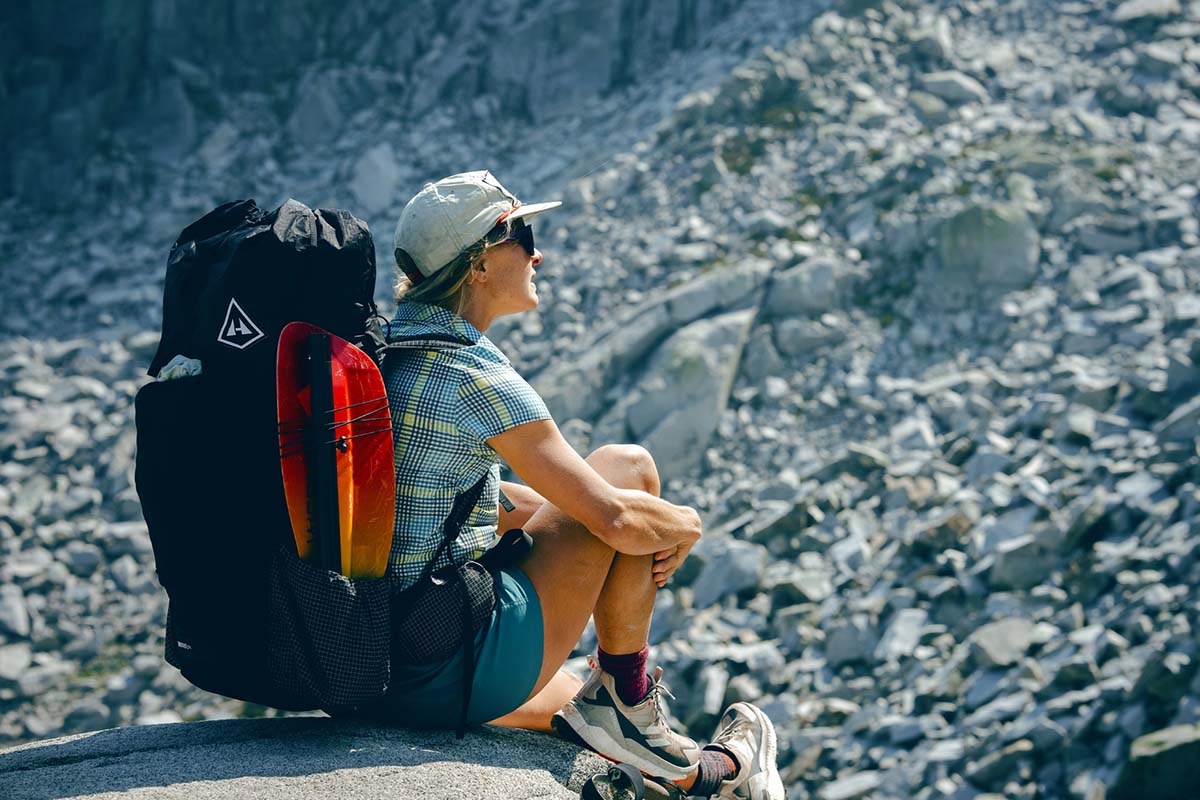
No matter what time of year you’re hitting the trail, you’ll want a hiking shirt that can wick moisture, keep air flowing, and move with you. Thin polyester designs like the Patagonia Capilene Cool Daily or Columbia Cirque River Pro are the best for venturing out in real-deal heat: They’re breathable, lightweight and free-flowing, and their hydrophobic nature means they’re much quicker to dry than merino wool, lyocell, or thicker nylon. Natural fibers are excellent for wicking sweat, but they absorb moisture and take some time to dry out (and merino does have insulative properties, which are unwelcome on hot days). Nylon sits at the bottom of the list in terms of both breathability and ventilation, making it best suited for mild conditions and when durability matters most.
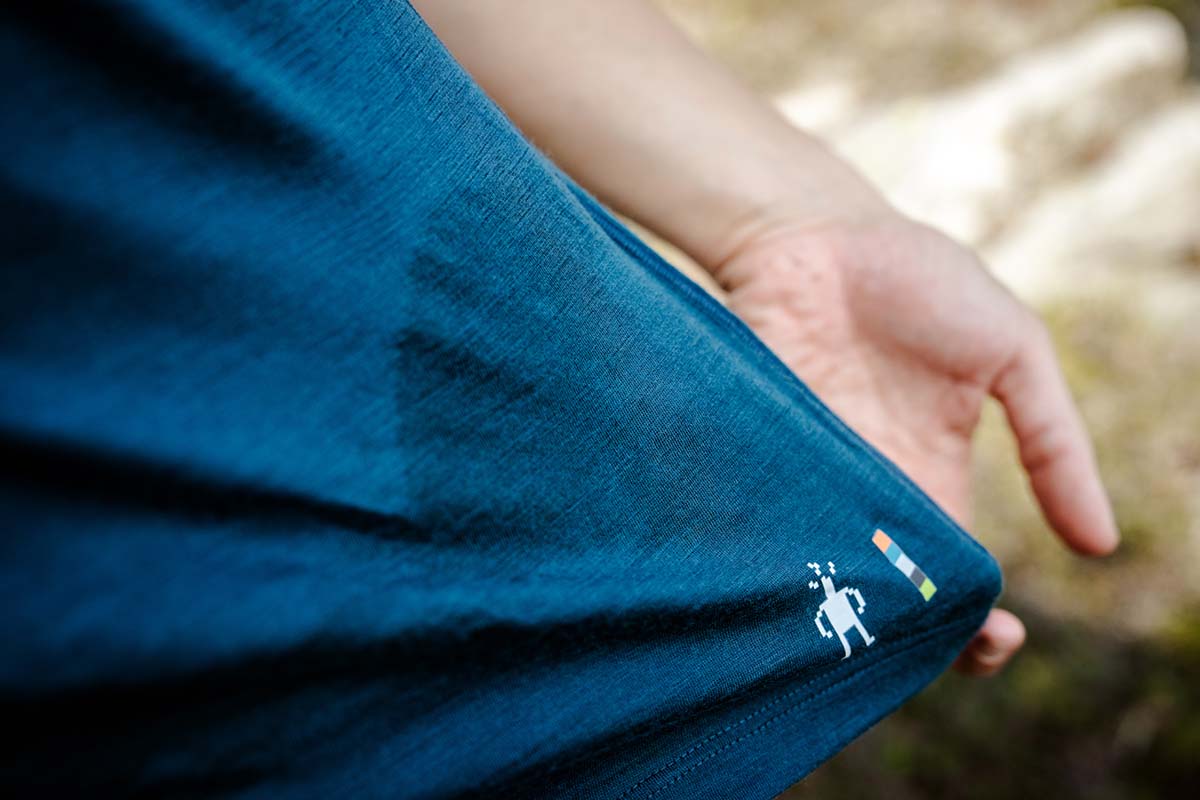
It's also worth thinking about how a shirt's fit and features help with ventilation. Free-flowing shirts can feel a lot better in warm temperatures than snug-fitting designs; and most of the shirts on our list are fairly loose fitting (even the trimmer designs like the Duckworth Vapor Tee are not skin-tight). Button-up shirts also boost airflow with built-in ventilation at the front (in between the buttons/snaps) and a neckline that can be lowered to allow more air in. And as mentioned above, most also feature venting at the back.
Most of us aren't buying hiking shirts for their warmth—in this category, it's generally about coverage and breathability. That said, all fabric insulates at least a little, which should be an important consideration in the purchasing process. In general, synthetics and natural fibers like lyocell add as little warmth as possible, and might even have some inherent cooling properties (we've experienced this in many a sun hoody). On the other hand, merino is naturally insulative and provides a noticeable amount of warmth even in the thinner varieties—especially if you're generating some of your own heat (we've experienced this firsthand with a shirt like the Ridge Merino Wander). As a result, we recommend against merino for warm and sunny conditions, but in mild weather, it can provide a nice first barrier against the chill while also promoting breathability.
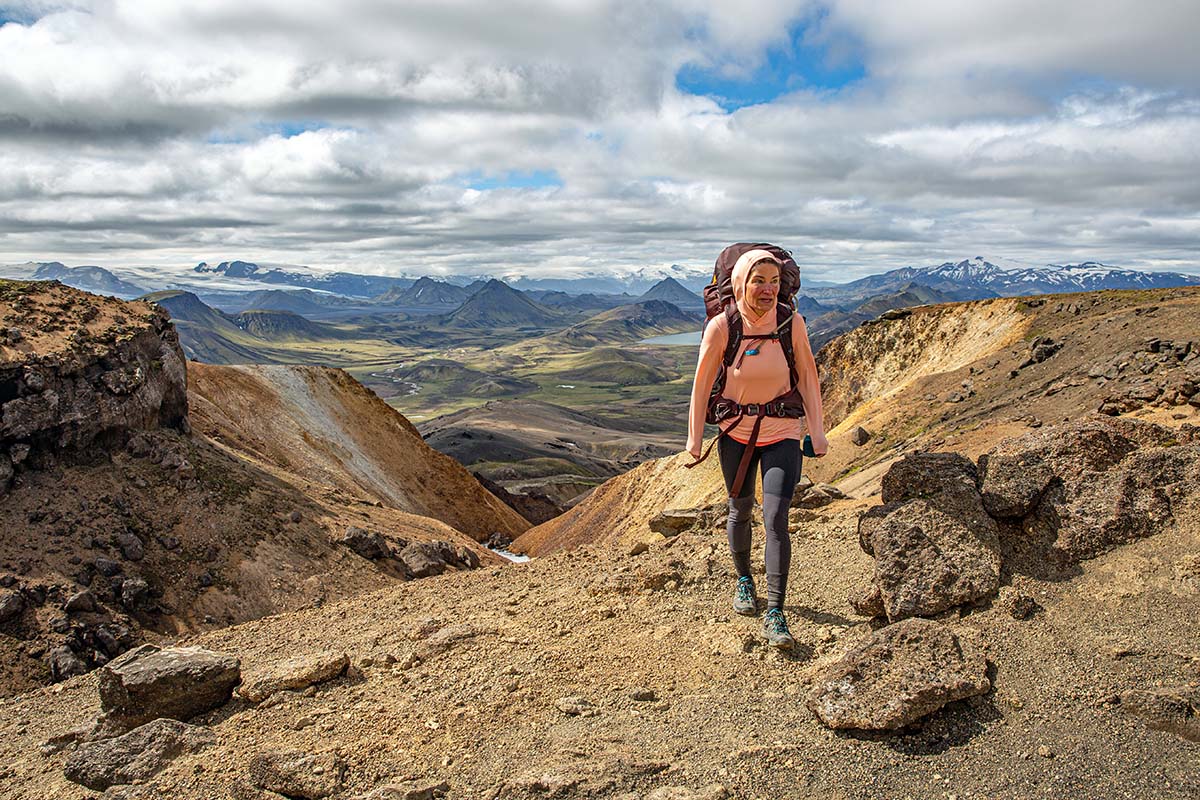
A fabric's weight can also be an important spec to consider, especially when discerning between similar designs. This is often given in grams per square meter (g/m2, or gsm) or ounces per square yard. For example, the Patagonia Capilene Cool Daily uses 3.7-ounce polyester, while the Capilene Cool Lightweight uses 2.3-ounce polyester. In terms of merino, Icebreaker gives their Tech Lite above a 150-gram designation, while the Merino Blend 125 Cool-Lite Sphere (not included here) uses 125-gram merino. In looking at these apples-to-apples comparisons, it's clear which shirt is heavier (and thus, warmer) than the other. Unfortunately, this isn't a foolproof strategy: Not every shirt specifies a fabric weight, nor does it perfectly align with warmth due to variations in fit and material, especially when it comes to blended materials.
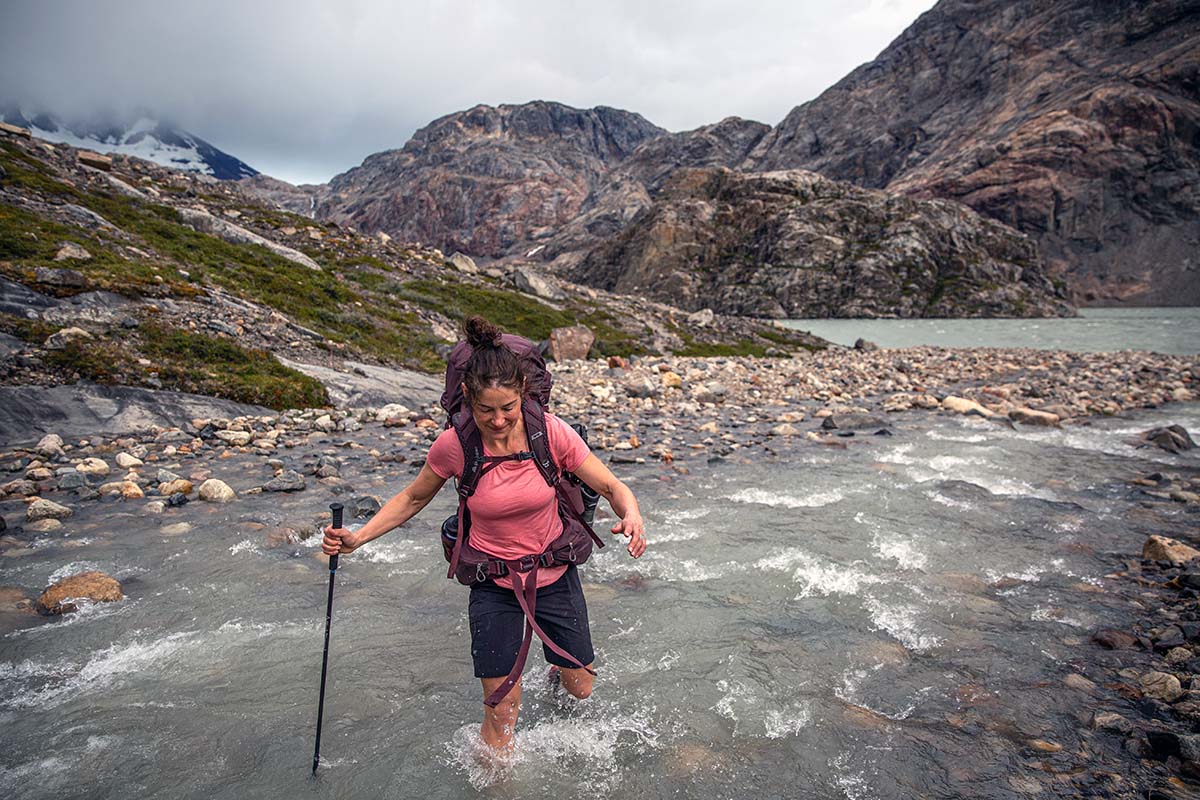
Synthetic fabrics are known to build stink, which isn’t a great characteristic when sweat is a given. To help keep B.O. at bay, most modern synthetic sun shirts incorporate some sort of anti-odor treatment. Patagonia uses a technology called HeiQ Pure on their Capilene Cool Daily, while Outdoor Research’s Echo features their ActiveFresh tech. These technologies generally work quite well, which is good news for everyone. And if you prefer to keep your clothing natural and chemical-free, natural fibers like wool are impressively odor-resistant without any additional treatments.
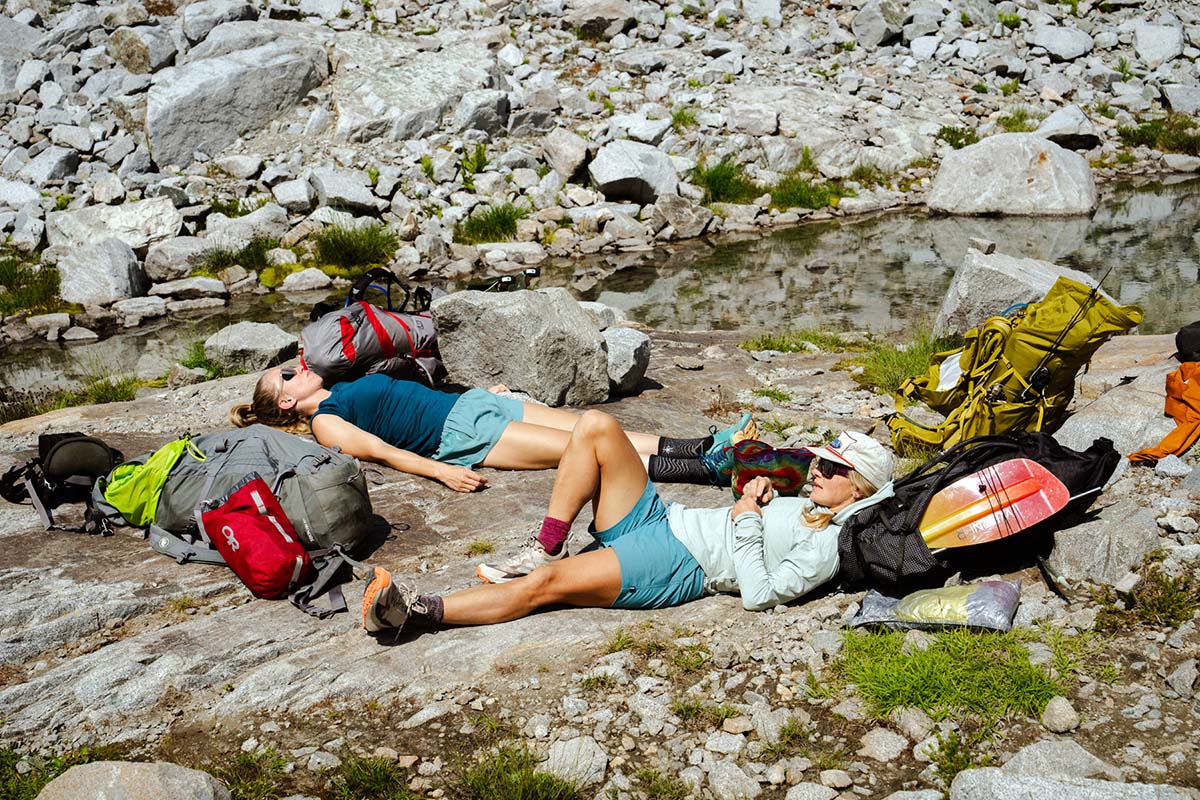
Most hiking shirts have a UPF rating, which gives an estimate of how much UV radiation the fabric allows to pass through. A UPF rating of 50 means that just 1/50th (or 2%) of the available UV rays are able to make their way to the other side of the fabric, while a UPF rating of 30 denotes that 1/30th of rays will pass through. For reference, a UPF of 15 is the lowest possible rating, and 50+ is the highest (of note: UPF 30 is the minimum rating that qualifies for the Skin Cancer Foundation’s official recommendation). And of course, if you’re wearing more than one layer, you get more sun protection. We have yet to meet anyone who’s been burned through a hiking shirt, but if your priority is maximizing sun protection, it’s worth aiming for the higher numbers.
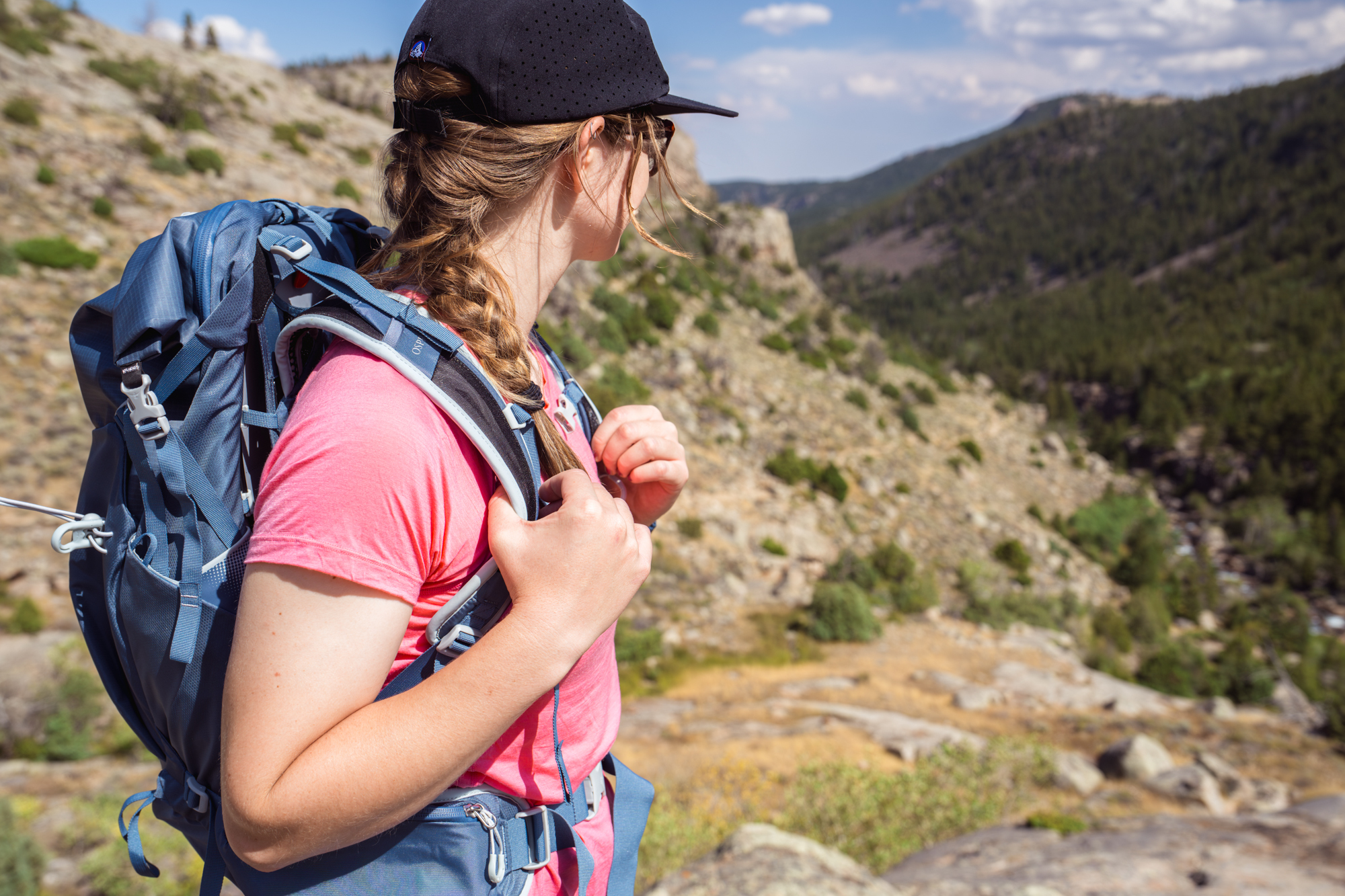
Several factors contribute to a hiking shirt’s UPF rating, including the fabric thickness and color, fiber type (polyester and nylon are more effective than wool and cotton), and whether or not the material has been treated with a UV-resistant chemical or dye. In general, darker fabrics offer better sun protection than lighter-colored fabrics, but that's not a total given. And to boost protection, one technique (used by Patagonia) is to apply a titanium dioxide additive to the yarn, similar to the active ingredient in many reef-safe sunscreen products. This allows manufacturers to use lightweight, breathable fabrics while still maximizing UV resistance.
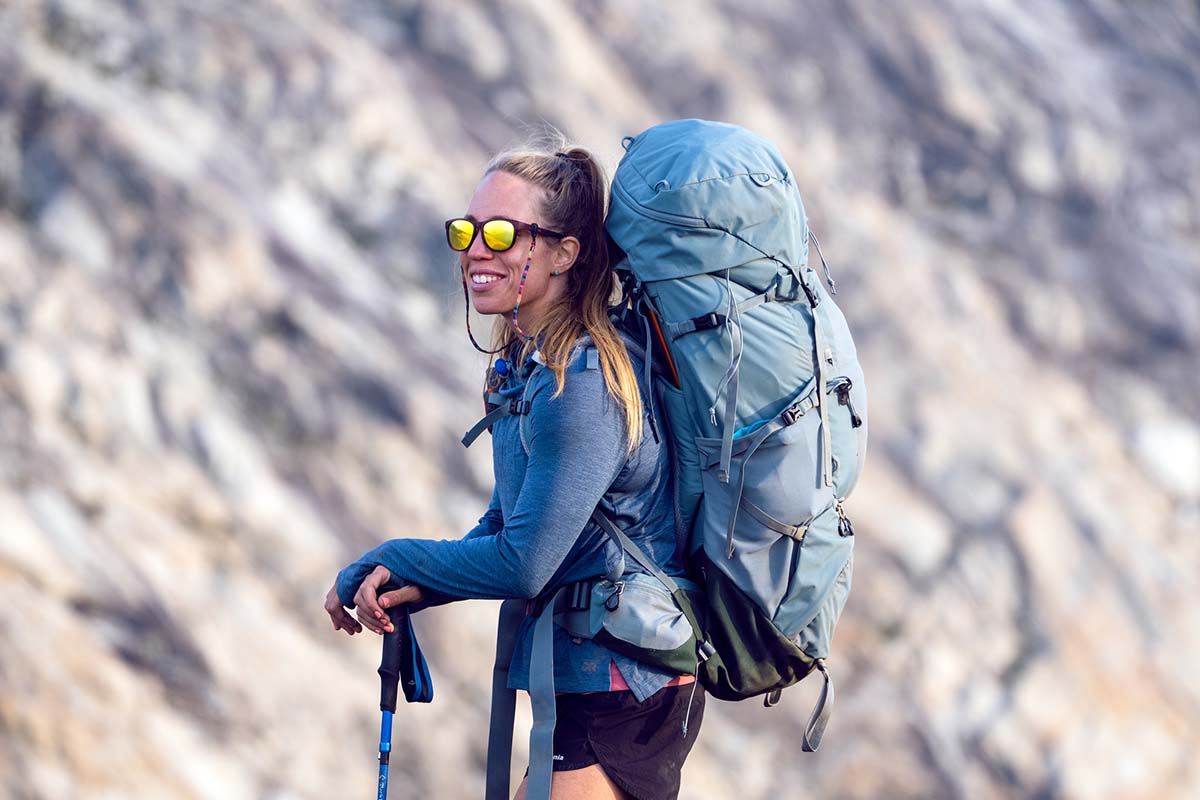
Hiking shirts can vary a great deal in terms of durability: Some are built to handle the rigors of bushwacking and hard use, while others are so thin they’re prone to ripping and snagging. Nylon is particularly hardwearing—seen in designs like the REI Co-op Sahara Solid LS and Outdoor Research Astroman—and polyester is next in line. Merino wool will not hold up well to sustained wear and tear. Natural fibers like lyocell, bamboo, and modal are somewhere in the middle, and when blended with some percentage of polyester or spandex, we've found them to be fully sufficient for activities like hiking and backpacking. Finally, thicker fabrics generally offer better tear resistance than thinner designs (the Town Shirt Sun Hoodie compared to the thinner OR Echo Hoodie, for example), although fabrics of any weight can be prone to pilling and snagging.
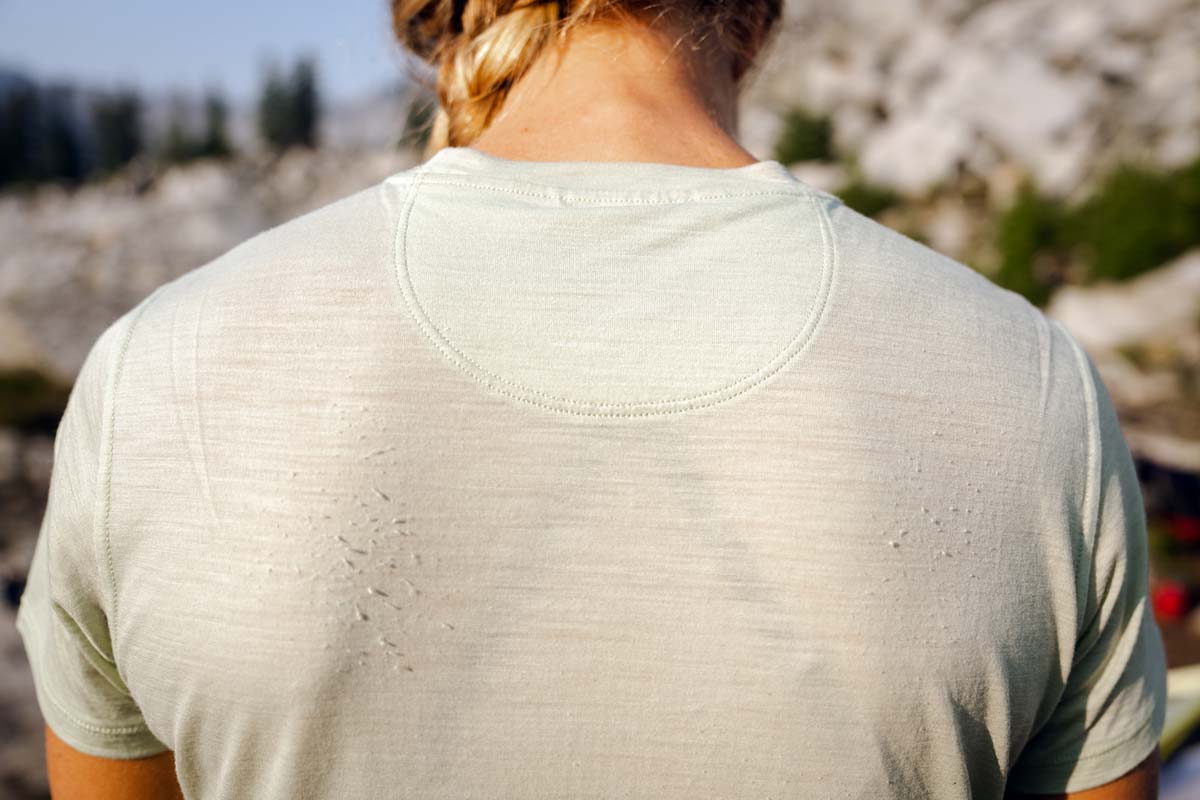
Hiking shirts are incredibly simple pieces of gear, many of which have very few features to speak of. Take the Patagonia Capilene Cool Daily, for example: it’s just a t-shirt, nothing less and nothing more. Under the hood, these simple shirts will have a few features we love to see, including streamlined stitching or offset seams, both of which help to reduce chafing when worn underneath a pack. On the other hand, a shirt like the Rabbit High Country has a more feature-rich design, including a front metal snap closure and perforated vents at the back. Some shirts also add a small chest pocket or zippered pocket at the hip, and long-sleeve shirts can often tack on thumb loops (helpful for maintaining coverage down the arm) and hoods.
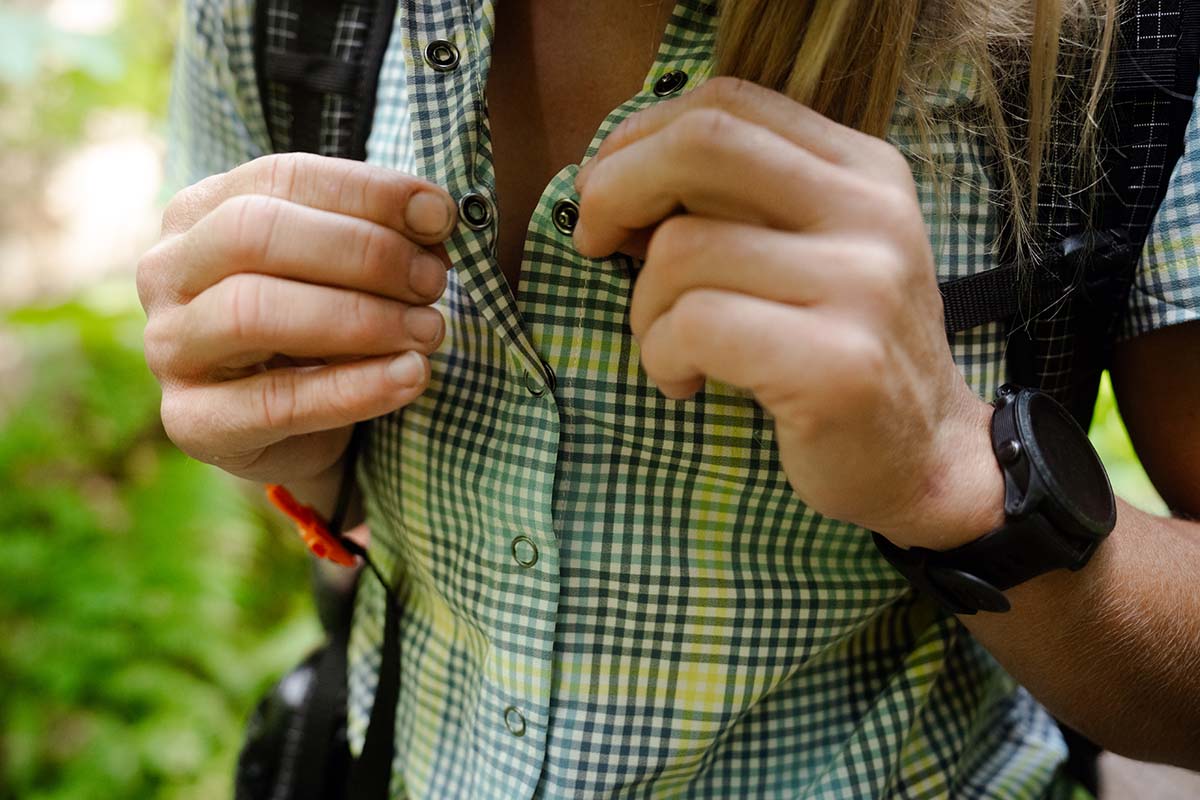
There are a few factors worth considering when looking at hoods. Size is the first: You’ll want to think about whether or not you want to wear the hood over your bare head, a ball cap, or a climbing helmet. Further, some hoods incorporate a drawcord, which can be a nice feature in the wind, although we rarely find ourselves using it. If you opt for this style, we’d recommend a sleek system like that on the REI Co-op Sahara Shade Hoodie or Jolly Gear Triple Crown over a design with a long drawcord, as the latter can get in the way and is largely impractical. A hat can be an excellent way to tame an unruly hood—not only does it keep it off your face, but it also provides friction to secure it in place in the wind or while hiking briskly.
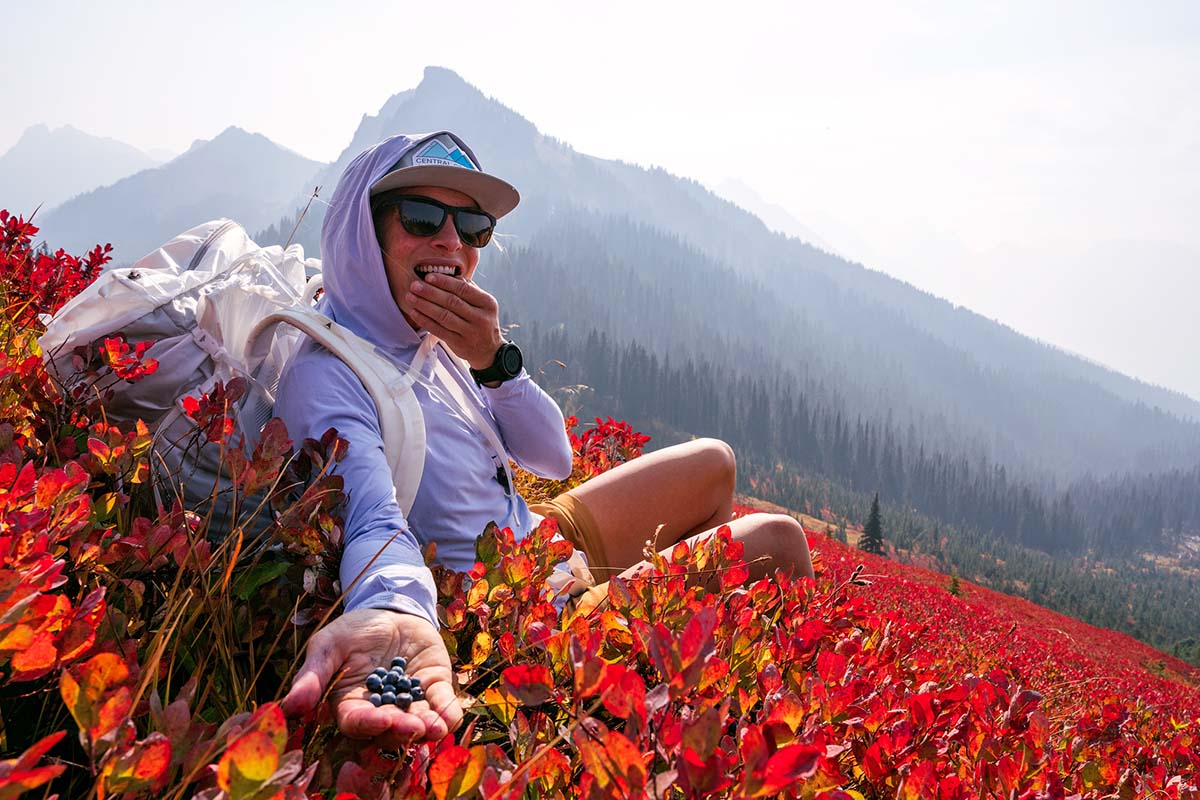
The two most common fits we see among hiking shirts are regular (or relaxed) and trim (or slim). Regular shirts might feature a bit of shape at the waist, but in general, they’re meant to drape in a relaxed manner and not cling tightly. Trim-fitting shirts, on the other hand, are usually made with decently stretchy material and are built to fit snugly. They’re usually not skin-tight, but they do follow the contours of the body. This distinction is apparent in Patagonia’s Capilene Cool line—the Daily features a regular fit, while the Lightweight is a slim fit. Button-ups are generally relaxed, but there’s still some variation within the category. For example, the Rabbit High Country is fairly svelte (Rabbit advertises it as semi-relaxed), while the Outdoor Research Astroman Sun Shirt has particularly roomy dimensions.
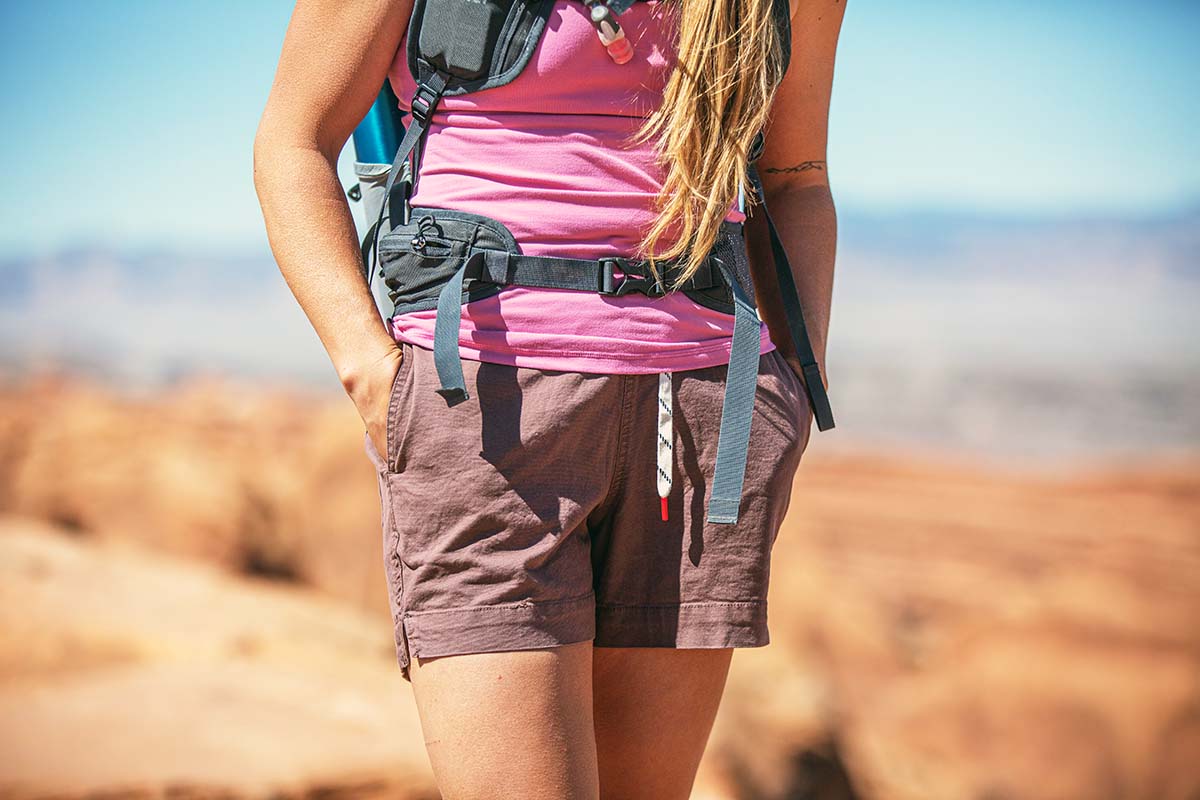
Shirts with built-in stretch are a popular choice for hiking, and for good reason: They feel great, and the extra “give” in the fabric is appreciated both on the trail (for freedom of movement while hiking and scrambling) and at camp (for bending down to cook, setting up a backpacking tent, etc.). In terms of construction, stretchy shirts fall into two camps: designs with an elastane (spandex) blend and those that are woven with mechanical stretch. The former type gets you the most elasticity, and we particularly love the extra-stretchy feel of a shirt like the Rabbit High Country (12% spandex). But a 100% merino or polyester shirt can still have quite a bit of give and certainly enough for most intended uses (one of our favorites is the all-merino Icebreaker Merino 150 Tech Lite). Even if manufacturers don’t advertise it, we’ve found most hiking shirts have a bit of added stretch. This is by no means a necessary feature—a relaxed non-stretchy design can offer similar amounts of mobility—but a forgiving/soft shirt is a nice luxury item in the backcountry.
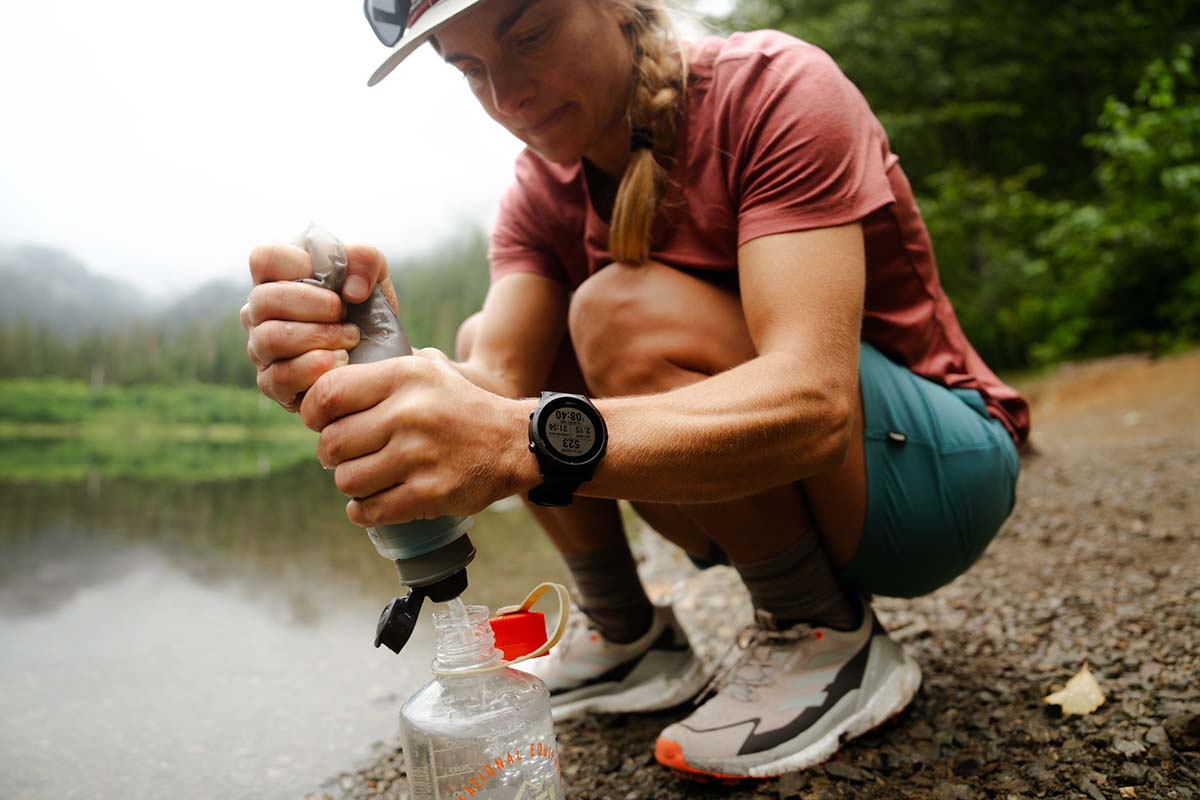
One of the primary ways we see manufacturers innovating is through the use of more sustainable materials and practices. In terms of hiking shirts, this means recycled and/or natural fabrics (like modal, lyocell, and merino), more responsible production practices (including the elimination of harmful chemicals used in UV-resistant treatments), and an emphasis on the ethical treatment of workers, often denoted by a “Fair Trade” certification. Many companies also utilize the Bluesign system for sourcing materials responsibly. Patagonia is a clear leader in the sustainability movement, and brands like Outdoor Research, REI, and Arc'teryx have also made a sizable effort to reduce their footprint. Finally, while we encourage you to shop sustainably, we’re also big advocates of lowering consumption by reusing old gear—hiking shirts are a dime a dozen at our local consignment shop, many of them with a lot of life left to be had.
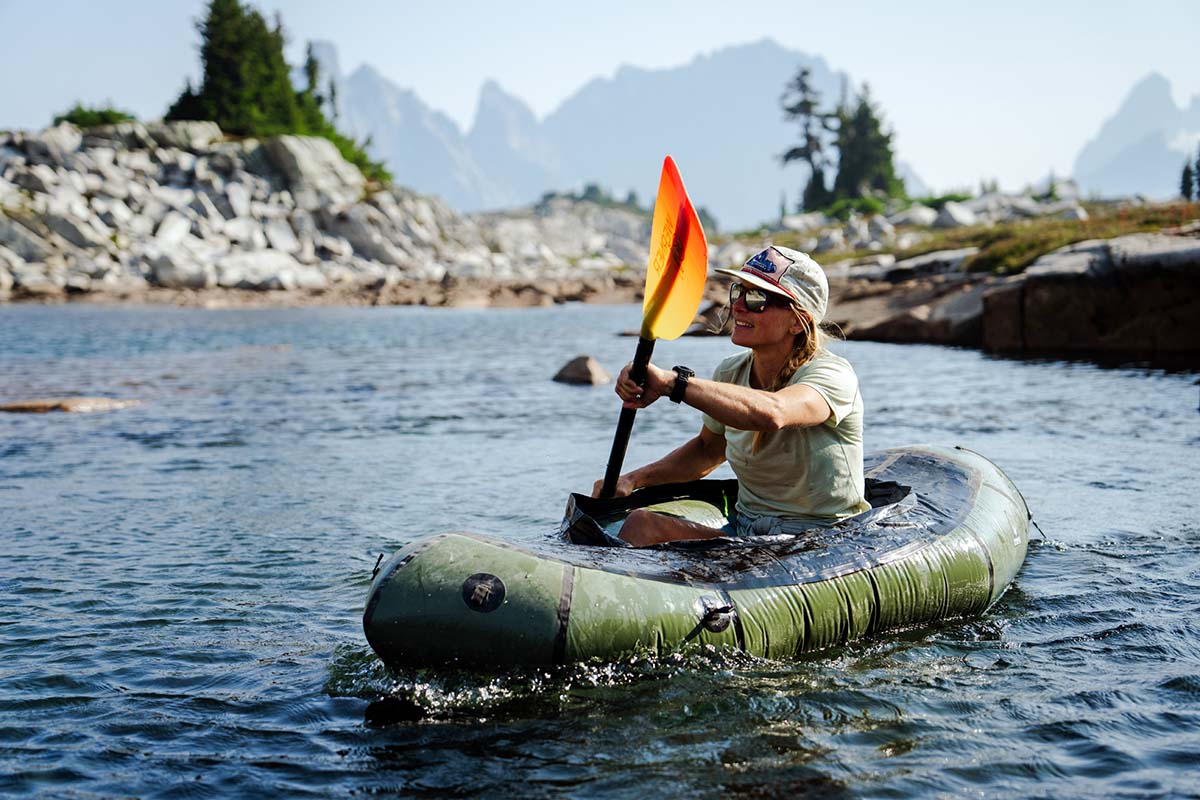
The vast majority of hikers head out in fair-weather conditions when a t-shirt, sun hoody, or button-up is the primary layer of choice. But for cooler evenings or shoulder-season conditions, you’ll want more insulation. When layering is in the forecast, we’ll generally leave the button-ups at home and stick with a short- or long-sleeve shirt or sun hoody as our primary layer.
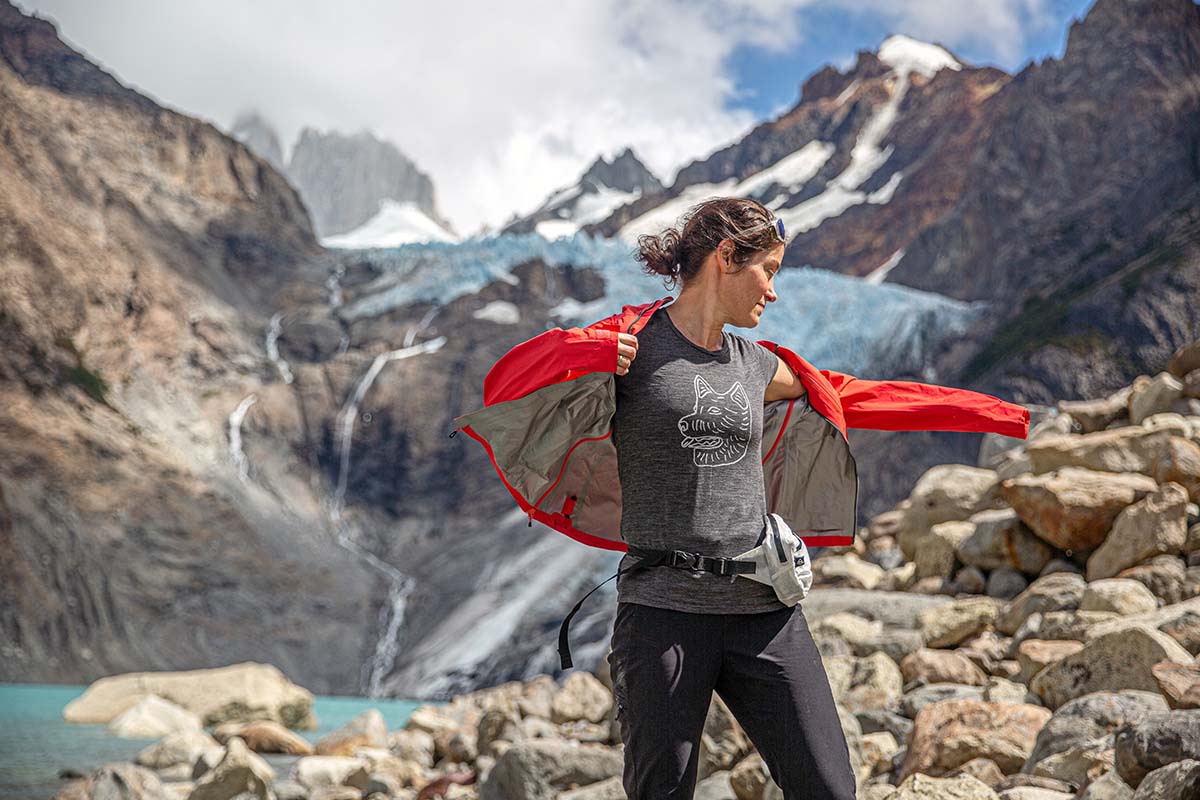
What kind of jacket you choose to layer on top of your hiking shirt will come down to weather and personal preference. For windy conditions or when you just need to cut a little chill, we love a windbreaker jacket, especially those with stretchy and breathable designs like the Patagonia Houdini Air or Black Diamond Alpine Start. If you need to add more warmth, a performance fleece or breathable synthetic jacket is an ideal outer layer. For technical fleeces, we particularly love the Arc’teryx Kyanite Jacket and Black Diamond Coefficient LT Hybrid Hoody; our go-to synthetic jackets are the Patagonia Nano-Air and Arc’teryx Proton Lightweight. And if precipitation is in the forecast, a rain jacket or hardshell is your best bet—we particularly love stretchy and breathable designs like the Black Diamond Fineline Stretch and Outdoor Research Microgravity.
Back to Our Top Women's Hiking Shirt Picks Back to Our Women's Hiking Shirt Comparison Table